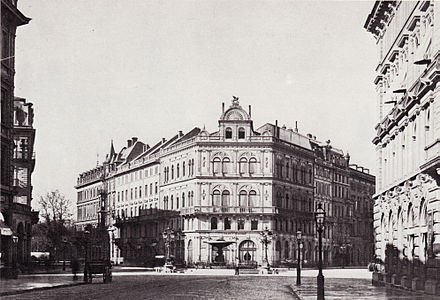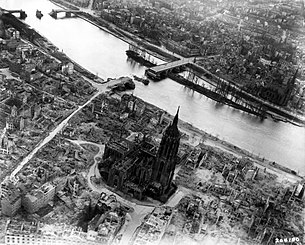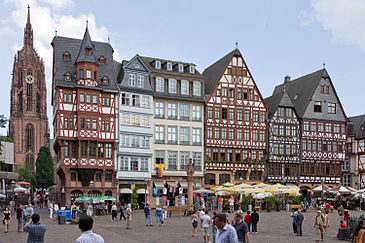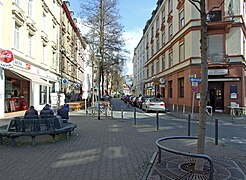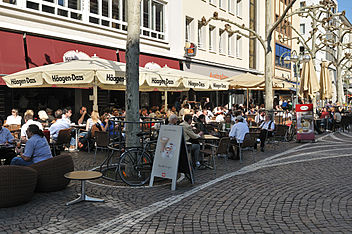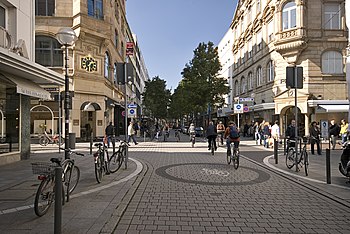Frankfurt
Frankfurt
Frangford am Maa ( Main River | ||
|---|---|---|
Location of Frankfurt within Hesse Lord Mayor Mike Josef[1] (SPD) | | |
| • Governing parties | Greens / SPD / FDP / Volt | |
| Area | ||
| • City | 248.31 km2 (95.87 sq mi) | |
| Elevation | 112 m (367 ft) | |
| Population (2022-12-31)[4] | ||
| • City | 773,068 | |
| • Density | 3,100/km2 (8,100/sq mi) | |
| • Urban | 2,319,029[3] | |
| • Metro | 5,604,523[2] | |
| Time zone | UTC+01:00 (CET) | |
| • Summer (DST) | UTC+02:00 (CEST) | |
| Postal codes | 60306–60599, 65929–65936 | |
| Dialling codes | 069, 06101, 06109 | |
| Vehicle registration | F | |
| Website | frankfurt | |
Frankfurt, officially Frankfurt am Main (German:
Frankfurt was a
Frankfurt is a global hub for commerce, culture, education, tourism and transportation, and is the site of many global and European corporate headquarters. Due to its central location in the former
Frankfurt is home to influential
Distinctions
Frankfurt is the largest financial hub in continental Europe. It is home to the European Central Bank, Deutsche Bundesbank, Frankfurt Stock Exchange and several large commercial banks.
The Frankfurt Stock Exchange is one of the world's largest stock exchanges by market capitalization and accounts for more than 90 percent of the turnover in the German market.
In 2010, 63 national and 152 international banks had their registered offices in Frankfurt, including Germany's major banks, notably
Frankfurt is considered a global city (alpha world city) as listed by the GaWC group's 2012 inventory.[9] Among global cities it was ranked tenth by the Global Power City Index 2011 and 11th by the Global City Competitiveness Index 2012. Among financial hubs, the city was ranked eighth by the International Financial Centers Development Index 2013 and ninth in the 2013 Global Financial Centres Index.
Its central location in Germany and Europe makes Frankfurt a major air, rail, and road
Frankfurt has many downtown
Etymology
Frankonovurd (in

By the 19th century, the name Frankfurt had been established as the official spelling. The older English spelling of Frankfort is now rarely seen in reference to Frankfurt am Main, although more than a dozen other towns and cities, mainly in the United States, use this spelling, including
The suffix am Main has been used regularly since the 14th century. In English, the city's full name of Frankfurt am Main means "Frankfurt on the Main" (pronounced like English mine or German mein). Frankfurt is located on an ancient ford (German: Furt) on the river Main. As a part of early Franconia, the inhabitants were the early Franks, thus the city's name reveals its legacy as "the ford of the Franks on the Main".[15]
Among English speakers, the city is commonly known simply as Frankfurt, but Germans occasionally call it by its full name to distinguish it from the other (significantly smaller) German city of Frankfurt an der Oder in the Land of Brandenburg on the Polish border.
The city district Bonames has a name probably dating back to Roman times, thought to be derived from bona me(n)sa (good table).
The common abbreviations for the city, primarily used in railway services and on road signs, are Frankfurt (Main), Frankfurt (M), Frankfurt a. M., Frankfurt/Main or Frankfurt/M. The common
History
historical affiliations
Roman Empire, pre 475
Francia, ca. 475–843
East Francia, 843–962
Holy Roman Empire, 962–1806
Free City of Frankfurt, 1372–1806
Grand Duchy of Frankfurt, 1806–1813
Free City of Frankfurt, 1813–1866
Kingdom of Prussia, 1866–1871
German Empire, 1871–1918
Weimar Republic, 1918–1933
German Reich, 1933–1945
American occupation zone, 1945–1949
West Germany, 1949–1990
Germany, 1990–present
Early history and Holy Roman Empire
At the western borders of Frankfurt lies the
Alemanni and Franks lived there, and by 794, Charlemagne presided over an imperial assembly and church synod, at which Franconofurd (alternative spellings end with -furt and -vurd) was first mentioned. It was one of the two capitals of Charlemagne's grandson Louis the German, together with Regensburg. Louis founded the collegiate church, rededicated in 1239 to Bartholomew the Apostle and now Frankfurt Cathedral.[17]
Frankfurt was one of the most important cities in the
The
In 1372, Frankfurt became a Reichsstadt (
In 1585, Frankfurt traders established a system of exchange rates for the various currencies that were circulating to prevent cheating and extortion. Therein lay the early roots for the Frankfurt Stock Exchange.
Frankfurt managed to remain neutral during the Thirty Years' War, but suffered from the bubonic plague that refugees brought to the city. After the war, Frankfurt regained its wealth. In the late 1770s the theater principal Abel Seyler was based in Frankfurt, and established the city's theatrical life.[18]
-
Frankfurt in 1612
-
Frankfurt in 1872
-
Kaiserplatz, c. 1880
Impact of French revolution and the Napoleonic Wars
Following the
Frankfurt as a fully sovereign state
After Napoleon's final defeat and abdication, the Congress of Vienna (1814–1815) dissolved the grand-duchy and Frankfurt became a fully sovereign city-state with a republican form of government. Frankfurt entered the newly founded German Confederation (till 1866) as a free city, becoming the seat of its Bundestag, the confederal parliament where the nominally presiding Habsburg Emperor of Austria was represented by an Austrian "presidential envoy".
After the ill-fated
Frankfurt after the loss of sovereignty

Frankfurt lost its independence after the
In 1914, the citizens founded the University of Frankfurt, later named Goethe University Frankfurt. This marked the only civic foundation of a university in Germany; today it is one of Germany's largest.
From 6 April to 17 May 1920, following military intervention to put down the
During World War II, Frankfurt was the location of a Nazi prison for underage girls with several forced labour camps,[22] a camp for Sinti and Romani people (see Romani Holocaust),[23] the Dulag Luft West transit camp for Allied prisoners of war,[24] and a subcamp of the Natzweiler-Struthof concentration camp.[25]
Frankfurt was severely bombed in World War II (1939–1945). About 5,500 residents were killed during the raids, and the once-famous medieval city center, by that time the largest in Germany, was almost completely destroyed. It became a ground battlefield on 26 March 1945, when the Allied advance into Germany was forced to take the city in contested urban combat that included a river assault. The 5th Infantry Division and the 6th Armored Division of the United States Army captured Frankfurt after several days of intense fighting, and it was declared largely secure on 29 March 1945.[26]
After the end of the war, Frankfurt became a part of the newly founded state of Hesse, consisting of the old
Frankfurt was the original choice for the provisional capital city of the newly founded state of
Postwar reconstruction took place in a sometimes simple modern style, thus changing Frankfurt's architectural face. A few landmark buildings were reconstructed historically, albeit in a simplified manner (e.g.,
The end of the war marked Frankfurt's comeback as Germany's leading financial hub, mainly because Berlin, now a city divided into four sectors, could no longer rival it. In 1948, the Allies founded the Bank deutscher Länder, the forerunner of Deutsche Bundesbank. Following this decision, more financial institutions were re-established, e.g. Deutsche Bank and Dresdner Bank. In the 1950s, Frankfurt Stock Exchange regained its position as the country's leading stock exchange.
Frankfurt also reemerged as Germany's transportation hub and
During the 1970s, the city created one of Europe's most efficient underground transportation systems.
In 1998, the European Central Bank was founded in Frankfurt, followed by the European Insurance and Occupational Pensions Authority and European Systemic Risk Board in 2011.
Geography


Frankfurt is the largest city in the state of Hesse in the western part of Germany.
Site
Frankfurt is located on both sides of the river Main, south-east of the Taunus mountain range. The southern part of the city contains the Frankfurt City Forest, Germany's largest city forest. The city area is 248.31 km2 (95.87 sq mi) and extends over 23.4 km (14.54 mi) east to west and 23.3 km (14.48 mi) north to south. Its downtown is north of the river Main in Altstadt district (the historical center) and the surrounding Innenstadt district. The geographical center is in Bockenheim district near Frankfurt West station.
Frankfurt at the heart of the densely populated
.Districts

The city is divided into 46 city districts (Stadtteile), which are in turn divided into 121 city boroughs (Stadtbezirke) and 448 electoral districts (Wahlbezirke). The 46 city districts combine into 16 area districts (
The largest city district by population and area is Sachsenhausen, while the smallest is Altstadt, Frankfurt's historical center. Three larger city districts (Sachsenhausen, Westend and Nordend) are divided for administrative purposes into a northern (-Nord) and a southern (-Süd) part, respectively a western (-West) and an eastern (-Ost) part, but are generally considered as one city district (which is why often only 43 city districts are mentioned, even on the city's official website).[29]
Some larger housing areas are often falsely called city districts, even by locals, like Nordweststadt (part of
Many city districts are incorporated suburbs (
History of incorporations
Until the year 1877 the city's territory consisted of the present-day inner-city districts of
.On 1 April 1928 the City of
Dornbusch became a city district in 1946. It was created on territory that had formerly belonged to Eckenheim and Ginnheim.
On 1 August 1972, Hesse's smaller suburbs of
.Frankfurt's youngest city district is Frankfurter Berg. It was part of Bonames until 1996.
Kalbach was officially renamed Kalbach-Riedberg in 2006 because of the large residential housing development in the area known as Riedberg.
Neighboring districts and cities

To the west Frankfurt borders the
Together with these towns (and some larger nearby towns, e.g., Hanau, Rodgau, Dreieich, Langen) Frankfurt forms a contiguous built-up urban area called Stadtregion Frankfurt which is not an official administrative district. The urban area had an estimated population of 2.3 million in 2010, and is the 13th-largest urban area in the EU.
Climate
Frankfurt has a
Due to its location at the northern tip of the Upper Rhine Valley in the Southwest of Germany, Frankfurt is one of the warmest and driest major German cities along with Darmstadt, Mannheim, Karlsruhe and Freiburg im Breisgau. Summers in Frankfurt can get quite hot when compared to the rest of the country. On average, it sees 62 days with a daily high temperature above 25 °C and 18 days with a high above 30 °C per year.
Climate change is elevating the number of hot days. In the year of 2018, Frankfurt recorded 108 days with a maximum over 25 °C and 43 days with a high above 30 °C. This is compared to 52 and 13 days on average per year between 1981 and 2010. The overall tendency for higher temperatures can also be seen when comparing the climate data from 1981 to 2010 with the data from 2010 to 2020. Being an urban heat island, Frankfurt sometimes experiences tropical nights, where the temperature does not fall below 20 °C between May and September. This is exacerbated and made more frequent as the density of the city stores daytime heat overnight.
The growing season is longer when compared to the rest of Germany, thus resulting in an early arrival of springtime in the region, with trees typically leafing out already toward the end of March.
Winters in Frankfurt are generally mild or at least not freezing with a small possibility of snow, especially in January and February but dark and often overcast. Frankfurt is, on average, covered with snow only for around 10 to 20 days per year.[30] The temperature falls below 0 °C on about 64 days and the daily maximum stays below freezing for about 10 days on average per year. Some days with lows under −10 °C can occur more often here than at the coasts of Northern Germany, but not as frequently as in Bavaria or the eastern parts of Germany.
Because of the mild climate in the region, there are some well-known wine regions in the vicinity such as
| Climate data for Frankfurt Airport 1991–2020, extremes 1949–present | |||||||||||||
|---|---|---|---|---|---|---|---|---|---|---|---|---|---|
| Month | Jan | Feb | Mar | Apr | May | Jun | Jul | Aug | Sep | Oct | Nov | Dec | Year |
| Record high °C (°F) | 15.9 (60.6) |
19.1 (66.4) |
24.7 (76.5) |
30.3 (86.5) |
33.2 (91.8) |
39.3 (102.7) |
40.2 (104.4) |
38.7 (101.7) |
32.8 (91.0) |
28.0 (82.4) |
19.1 (66.4) |
16.3 (61.3) |
40.2 (104.4) |
| Mean maximum °C (°F) | 12.1 (53.8) |
13.8 (56.8) |
19.0 (66.2) |
24.8 (76.6) |
28.9 (84.0) |
32.5 (90.5) |
34.1 (93.4) |
33.5 (92.3) |
27.8 (82.0) |
22.0 (71.6) |
16.6 (61.9) |
12.5 (54.5) |
35.6 (96.1) |
| Mean daily maximum °C (°F) | 4.9 (40.8) |
6.6 (43.9) |
11.4 (52.5) |
16.5 (61.7) |
20.4 (68.7) |
23.9 (75.0) |
26.1 (79.0) |
25.7 (78.3) |
20.8 (69.4) |
14.8 (58.6) |
8.9 (48.0) |
5.5 (41.9) |
15.5 (59.8) |
| Daily mean °C (°F) | 2.7 (36.9) |
3.5 (38.3) |
7.2 (45.0) |
11.5 (52.7) |
15.5 (59.9) |
18.9 (66.0) |
20.7 (69.3) |
20.1 (68.2) |
15.7 (60.3) |
10.8 (51.4) |
6.5 (43.7) |
3.4 (38.1) |
11.4 (52.5) |
| Mean daily minimum °C (°F) | −0.5 (31.1) |
−0.4 (31.3) |
2.2 (36.0) |
5.4 (41.7) |
9.3 (48.7) |
12.8 (55.0) |
14.8 (58.6) |
14.4 (57.9) |
10.6 (51.1) |
6.7 (44.1) |
3.2 (37.8) |
0.4 (32.7) |
7.0 (44.6) |
| Mean minimum °C (°F) | −9.1 (15.6) |
−7.2 (19.0) |
−4.2 (24.4) |
−1.4 (29.5) |
2.2 (36.0) |
7.0 (44.6) |
9.5 (49.1) |
8.7 (47.7) |
5.1 (41.2) |
−0.1 (31.8) |
−3.2 (26.2) |
−7.7 (18.1) |
−11.2 (11.8) |
| Record low °C (°F) | −21.6 (−6.9) |
−19.6 (−3.3) |
−13.0 (8.6) |
−7.1 (19.2) |
−2.8 (27.0) |
0.1 (32.2) |
2.8 (37.0) |
2.5 (36.5) |
−0.3 (31.5) |
−6.3 (20.7) |
−11.5 (11.3) |
−17.0 (1.4) |
−21.6 (−6.9) |
| Average precipitation mm (inches) | 44.0 (1.73) |
38.6 (1.52) |
38.7 (1.52) |
36.6 (1.44) |
60.4 (2.38) |
55.4 (2.18) |
63.5 (2.50) |
61.4 (2.42) |
47.7 (1.88) |
50.4 (1.98) |
47.3 (1.86) |
54.5 (2.15) |
598.5 (23.56) |
| Average precipitation days (≥ 0.1 mm) | 15.2 | 13.5 | 13.5 | 12.3 | 13.5 | 12.3 | 13.9 | 12.8 | 11.6 | 14.2 | 15 | 16.4 | 164.2 |
| Average snowy days (≥ 1.0 cm) | 4.9 | 3.3 | 1 | 0.1 | 0 | 0 | 0 | 0 | 0 | 0 | 0.6 | 3.3 | 13.2 |
| Mean monthly sunshine hours | 52 | 79 | 136 | 192 | 219 | 227 | 235 | 225 | 165 | 104 | 51 | 40 | 1,725 |
| Source 1: Deutscher Wetterdienst[32] | |||||||||||||
| Source 2: | |||||||||||||
| Climate data for Frankfurt | |||||||||||||
|---|---|---|---|---|---|---|---|---|---|---|---|---|---|
| Month | Jan | Feb | Mar | Apr | May | Jun | Jul | Aug | Sep | Oct | Nov | Dec | Year |
| Mean No. of days with Maximum temperature => 30.0 °C (86.0 °F) | 0 | 0 | 0 | 0 | 0.5 | 3.3 | 6.5 | 5.4 | 0.7 | 0 | 0 | 0 | 16.4 |
| Mean No. of days with Minimum temperature <= 0.0 °C (32.0 °F) | 15.8 | 15 | 8.8 | 2.9 | 0.1 | 0 | 0 | 0 | 0 | 1.7 | 6.2 | 13.6 | 64.1 |
| Mean No. of days with Maximum temperature <= 0.0 °C (32.0 °F) | 4.6 | 2.2 | 0.1 | 0 | 0 | 0 | 0 | 0 | 0 | 0 | 0.4 | 3 | 10.3 |
| Mean No. of days with snow depth => 1 cm (0.39 in) | 4.9 | 3.3 | 1.1 | 0.1 | 0 | 0 | 0 | 0 | 0 | 0 | 0.6 | 3.3 | 13.3 |
| Mean number of days with thunder | 0.2 | 0.4 | 0.7 | 2.1 | 4.5 | 5.3 | 6.2 | 5.5 | 1.6 | 0.6 | 0.3 | 0.1 | 27.5 |
| Mean number of days with hail | 0 | 0 | 0 | 0.1 | 0.1 | 0.2 | 0.2 | 0.1 | 0 | 0 | 0 | 0 | 0.8 |
| Mean number of days with fog | 3 | 2.5 | 1.1 | 0.4 | 0.5 | 0.5 | 0.3 | 0.5 | 1.1 | 4.4 | 4.2 | 3.9 | 32.2 |
| Number of days with no sunshine | 19.9 | 15.4 | 14.1 | 9.9 | 11 | 8.8 | 9.3 | 7.7 | 11.1 | 15 | 19.2 | 21.7 | 163.1 |
| Mean daily daylight hours | 9.0 | 10.0 | 12.0 | 14.0 | 15.0 | 16.0 | 16.0 | 14.0 | 13.0 | 11.0 | 9.0 | 8.0 | 12.3 |
| Average Ultraviolet index | 1 | 1 | 3 | 4 | 6 | 7 | 7 | 6 | 5 | 3 | 1 | 1 | 3.5 |
| Source 1: NOAA[33]
| |||||||||||||
| Source 2: Weather Atlas[35] | |||||||||||||
Demographics
Population
| Year | Pop. | ±% |
|---|---|---|
| 1387 | 9,600 | — |
| 1520 | 10,000 | +4.2% |
| 1750 | 32,000 | +220.0% |
| 1871 | 91,040 | +184.5% |
| 1895 | 229,279 | +151.8% |
| 1905 | 334,978 | +46.1% |
| 1925 | 467,520 | +39.6% |
| 1933 | 555,857 | +18.9% |
| 1939 | 553,464 | −0.4% |
| 1945 | 357,737 | −35.4% |
| 1950 | 532,037 | +48.7% |
| 1961 | 685,682 | +28.9% |
| 1970 | 669,635 | −2.3% |
| 1980 | 629,375 | −6.0% |
| 1985 | 595,348 | −5.4% |
| 1990 | 644,865 | +8.3% |
| 1995 | 650,055 | +0.8% |
| 2000 | 646,550 | −0.5% |
| 2005 | 651,899 | +0.8% |
| 2010 | 679,664 | +4.3% |
| 2015 | 732,688 | +7.8% |
| 2018 | 753,056 | +2.8% |
| 2020 | 764,104 | +1.5% |
| Population size may be affected by changes in administrative divisions. | ||
| Nationality | Population (30 June 2022) |
|---|---|
| 25,294 | |
| 16,751 | |
| 15,120 | |
| 12,174 | |
| 10,451 | |
| 9,748 | |
| 9,404 | |
| 8,509 | |
| 7,612 | |
| 7,364 | |
| 7,133 | |
| 6,581 | |
| 6,342 | |
| 5,114 | |
| 4,719 | |
| 4,632 | |
| 4,087 | |
| 3,991 | |
| 3,653 | |
| 3,374 |
With a population of 763,380 (2019) within its administrative boundaries
As of 2015, Frankfurt had 1909
During the 1970s, the state government of Hesse wanted to expand the city's administrative boundaries to include the entire urban area. This would have made Frankfurt officially the second-largest city in Germany after Berlin with up to 3 million inhabitants.[42] However, because local authorities did not agree, the administrative territory is still much smaller than its actual urban area.
Moroccan community
Frankfurt has the largest Moroccan community in Germany, numbering about 8,000 people, and the Rhine-Main area has about 20,000. Many Moroccans came as guest workers in the 1970s. Today Frankfurt has many Moroccan restaurants, companies, shops, mosques and hamams. Due to the popularity of Moroccan culture in Frankfurt, it also led many people from the Maghreb and other African countries to move to Frankfurt. Famous singer Namika was born in Frankfurt to Moroccan parents.
| No. |
City district (Stadtteil) |
Area in km2[43] |
Population[44] |
Foreign nationals[44] |
Foreign nationals in %[44] |
Area district (Ortsbezirk) |
|---|---|---|---|---|---|---|
| 1 | Altstadt | 0.51 | 3.475 | 1.122 | 32.3 | 01 – Innenstadt I |
| 2 | Innenstadt | 1.52 | 6.577 | 2.529 | 38.5 | 01 – Innenstadt I |
| 3 | Bahnhofsviertel |
0.53 | 2.125 | 810 | 38.1 | 01 – Innenstadt I |
| 4 | Westend-Süd | 2.47 | 17.288 | 3.445 | 19.9 | 02 – Innenstadt II |
| 5 | Westend-Nord | 1.67 | 8.854 | 2.184 | 24.7 | 02 – Innenstadt II |
| 6 | Nordend-West | 3.07 | 28.808 | 5.162 | 17.9 | 03 – Innenstadt III |
| 7 | Nordend-Ost | 1.69 | 26.619 | 5.580 | 21.0 | 03 – Innenstadt III |
| 8 | Ostend | 5.40 | 26.955 | 7.213 | 26.8 | 04 – Bornheim/Ostend |
| 9 | Bornheim | 2.66 | 27.184 | 6.240 | 23.0 | 04 – Bornheim/Ostend |
| 10 | Gutleutviertel |
2.20 | 5.843 | 1.953 | 33.4 | 01 – Innenstadt I |
| 11 | Gallus | 4.22 | 26.716 | 11.012 | 41.2 | 01 – Innenstadt I |
| 12 | Bockenheim | 8.04 | 34.740 | 9.034 | 26.0 | 02 – Innenstadt II |
| 13 | Sachsenhausen-Nord | 4.24 | 30.374 | 6.507 | 21.4 | 05 – Süd |
| 14 | Sachsenhausen-Süd | 34.91 | 26.114 | 4.847 | 18.6 | 05 – Süd |
| 15 | Flughafen |
20.00 | 211 | 14 | 6.6 | 05 – Süd |
| 16 | Oberrad |
2.74 | 12.828 | 3.113 | 24.3 | 05 – Süd |
| 17 | Niederrad |
2.93 | 22.954 | 6.569 | 28.6 | 05 – Süd |
| 18 | Schwanheim | 17.73 | 20.162 | 3.532 | 17.5 | 06 – West |
| 19 | Griesheim | 4.90 | 22.648 | 8.029 | 35.5 | 06 – West |
| 20 | Rödelheim |
5.15 | 17.841 | 4.863 | 27.3 | 07 – Mitte-West |
| 21 | Hausen | 1.26 | 7.178 | 2.135 | 29.7 | 07 – Mitte-West |
| 22/23 | Praunheim |
4.55 | 15.761 | 3.197 | 20.3 | 07 – Mitte-West |
| 24 | Heddernheim |
2.49 | 16.443 | 3.194 | 19.4 | 08 – Nord-West |
| 25 | Niederursel |
7.22 | 16.394 | 3.671 | 22.4 | 08 – Nord-West |
| 26 | Ginnheim |
2.73 | 16.444 | 4.024 | 24.5 | 09 – Mitte-Nord |
| 27 | Dornbusch | 2.38 | 18.511 | 3.482 | 18.8 | 09 – Mitte-Nord |
| 28 | Eschersheim |
3.34 | 14.808 | 2.657 | 17.9 | 09 – Mitte-Nord |
| 29 | Eckenheim |
2.23 | 14.277 | 3.674 | 25.7 | 10 – Nord-Ost |
| 30 | Preungesheim |
3.74 | 13.568 | 3.442 | 25.4 | 10 – Nord-Ost |
| 31 | Bonames |
1.24 | 6.362 | 1.288 | 20.2 | 10 – Nord-Ost |
| 32 | Berkersheim |
3.18 | 3.400 | 592 | 17.4 | 10 – Nord-Ost |
| 33 | Riederwald |
1.04 | 4.911 | 1.142 | 23.3 | 11 – Ost |
| 34 | Seckbach | 8.04 | 10.194 | 1.969 | 19.3 | 11 – Ost |
| 35 | Fechenheim |
7.18 | 16.061 | 5.635 | 35.1 | 11 – Ost |
| 36 | Höchst | 4.73 | 13.888 | 5.279 | 38.0 | 06 – West |
| 37 | Nied | 3.82 | 17.829 | 5.224 | 29.3 | 06 – West |
| 38 | Sindlingen |
3.98 | 9.032 | 2.076 | 23.0 | 06 – West |
| 39 | Zeilsheim |
5.47 | 11.984 | 2.555 | 21.3 | 06 – West |
| 40 | Unterliederbach |
5.85 | 14.350 | 3.511 | 24.5 | 06 – West |
| 41 | Sossenheim |
5.97 | 15.853 | 4.235 | 26.7 | 06 – West |
| 42 | Nieder-Erlenbach |
8.34 | 4.629 | 496 | 10.7 | 13 – Nieder-Erlenbach |
| 43 | Kalbach-Riedberg |
6.90 | 8.482 | 1.279 | 15.1 | 12 – Kalbach-Riedberg |
| 44 | Harheim |
5.02 | 4.294 | 446 | 10.4 | 14 – Harheim |
| 45 | Nieder-Eschbach |
6.35 | 11.499 | 1.978 | 17.2 | 15 – Nieder-Eschbach |
| 46 | Bergen-Enkheim |
12.54 | 17.954 | 2.764 | 15.4 | 16 – Bergen-Enkheim |
| 47 | Frankfurter Berg |
2.16 | 7.149 | 1.715 | 24.0 | 10 – Nord-Ost |
| Frankfurt am Main | 248.33 | 679.571 | 165.418 | 24.3 |
Immigration and foreign nationals
According to data from the city register of residents, 51.2% of the population had a migration background as of 2015, which means that a person or at least one or both of their parents was born with foreign citizenship. For the first time, a majority of the city residents had an at least part non-German background.[45] Moreover, three of four children in the city under the age of six had full or partial immigrant backgrounds,[46] and 27.7% of residents had a foreign citizenship.[47]
According to statistics, 46.7% of immigrants in Frankfurt come from other countries in the EU; 24.5% come from European countries that are not part of the EU; 15.7% come from Asia (including Western Asia and South Asia); 7.3% come from Africa; 3.4% come from North America (including the Caribbean and Central America); 0.2% come from Australia and New Zealand; 2.3% come from South America; and 1.1% come from Pacific island nations. Because of this the city is often considered to be a multicultural city, and has been compared to New York City, London, and Toronto.[citation needed]
Religion
Frankfurt was historically a
The Jewish community has a history dating back to medieval times and has always ranked among the largest in Germany. Over 7,200 inhabitants are affiliated with the Jewish community, making it the second largest in Germany after Berlin.[21] Frankfurt has four active synagogues.[49]
Due to the growing immigration of people from Muslim countries beginning in the 1960s, Frankfurt has a large Muslim community, estimated at 12% in 2006.[50] According to calculations based on census data for 21 countries of origin, the number of Muslim migrants in Frankfurt amounted to about 84,000 in 2011, making up 12.6% of the population.[51] The most prevalent countries of origin were Turkey and Morocco.
Government and politics
Mayor

The current Mayor is Mike Josef of the Social Democratic Party, who took the office on 11 May 2023.
The most recent mayoral election was held on 5 March 2023, with a runoff held on 26 March, and the results were as follows:
| Candidate | Party | First round | Second round | |||
|---|---|---|---|---|---|---|
| Votes | % | Votes | % | |||
| Uwe Becker | Christian Democratic Union | 70,411 | 34.5 | 86,307 | 48.3 | |
| Mike Josef | Social Democratic Party | 49,033 | 24.0 | 92,371 | 51.7 | |
| Manuela Rottmann | Alliance 90/The Greens | 43,502 | 21.3 | |||
| Peter Wirth | Independent | 10,397 | 5.1 | |||
| Daniela Mehler-Würzbach | The Left | 7,356 | 3.6 | |||
| Maja Wolff | Independent | 6,014 | 2.9 | |||
| Yanki Pürsün | Free Democratic Party | 5,768 | 2.8 | |||
| Andreas Lobenstein | Alternative for Germany | 4,628 | 2.3 | |||
| Mathias Pfeiffer | Citizens for Frankfurt | 1,565 | 0.8 | |||
| Katharina Tanczos | Die PARTEI | 1,176 | 0.6 | |||
| Khurrem Akhtar | Team Todenhöfer | 858 | 0.4 | |||
| Frank Großenbach | dieBasis | 744 | 0.4 | |||
| Tilo Schwichtenberg | Garden Party Frankfurt am Main | 661 | 0.3 | |||
| Sven Junghans | Independent | 574 | 0.3 | |||
| Yamòs Camara | Free Party Frankfurt | 487 | 0.2 | |||
| Niklas Pauli | Independent | 340 | 0.2 | |||
| Peter Pawelski | Independent | 325 | 0.2 | |||
| Feng Xu | Independent | 199 | 0.1 | |||
| Karl-Maria Schulte | Independent | 158 | 0.1 | |||
| Markus Eulig | Independent | 102 | 0.0 | |||
| Valid votes | 204,298 | 99.6 | 178,678 | 99.0 | ||
| Invalid votes | 921 | 0.4 | 1,754 | 1.0 | ||
| Total | 205,219 | 100.0 | 180,432 | 100.0 | ||
| Electorate/voter turnout | 508,510 | 40.4 | 510,336 | 35.4 | ||
| Source: City of Frankfurt am Main | ||||||
City council

The Frankfurt am Main city council (Stadtverordnetenversammlung) governs the city alongside the mayor. It is located in the city's medieval town hall, Römer, which is also used for representative and official purposes. The most recent city council election was held on 14 March 2021, and the results were as follows:
| Party | Lead candidate | Votes | % | +/- | Seats | +/- | |
|---|---|---|---|---|---|---|---|
| Alliance 90/The Greens (Grüne) | Martina Feldmayer | 4,894,339 | 24.6 | 23 | |||
| Christian Democratic Union (CDU) | Nils Kößler | 4,361,942 | 21.9 | 20 | |||
| Social Democratic Party (SPD) | Mike Josef | 3,385,017 | 17.0 | 16 | |||
| The Left (Die Linke) | Dominike Pauli | 1,572,333 | 7.9 | 7 | |||
| Free Democratic Party (FDP) | Annette Rinn | 1,515,646 | 7.6 | 7 | ±0 | ||
| Alternative for Germany (AfD) | Patrick Schenk | 902,412 | 4.5 | 4 | |||
| Volt Germany (Volt) | Eileen O'Sullivan | 745,418 | 3.7 | New | 4 | New | |
| Citizens for Frankfurt (BFF) | Mathias Mund | 395,905 | 2.0 | 2 | |||
| Ecological Left – Anti-Racist List (ÖkoLinX-ARL) | Jutta Ditfurth | 359,304 | 1.8 | 2 | ±0 | ||
| Die PARTEI (PARTEI) | Nico Wehnemann | 361,932 | 1.8 | 2 | |||
| Europe List for Frankfurt (ELF) | Luigi Brillante | 265,914 | 1.3 | 1 | ±0 | ||
| Free Voters (FW) | Eric Pärisch | 162,122 | 0.8 | 1 | ±0 | ||
| I am a Frankfurter (IBF) | Jumas Medoff | 166,573 | 0.8 | 1 | |||
| Alliance for Innovation and Justice (BIG) | Haluk Yıldız | 128,846 | 0.6 | New | 1 | New | |
| Garden Party Frankfurt am Main (Gartenpartei) | Tilo Schwichtenberg | 126,991 | 0.6 | New | 1 | New | |
| Pirate Party Germany (Piraten) | Herbert Förster | 123,772 | 0.6 | 1 | ±0 | ||
| Polish Dialogue Initiative for Frankfurt | Barbara Lange | 88,771 | 0.4 | New | 0 | New | |
| The Frankfurters (dFfm) | Bernhard Ochs | 73,026 | 0.4 | 0 | |||
| International Vote Frankfurt (ISF) | Kerry Reddington | 61,772 | 0.3 | New | 0 | New | |
| Climate List Frankfurt (Klimaliste) | Beate Balzert | 61,526 | 0.3 | New | 0 | New | |
| Free Party Frankfurt (FPF) | Benjamin Klinger | 40,621 | 0.2 | New | 0 | New | |
| United Democrats (VD) | André Leitzbach | 30,691 | 0.2 | New | 0 | New | |
| The Social Liberals (SL) | Christian Bethke | 18,563 | 0.1 | New | 0 | New | |
| Frankfurt Free Voter Group (FFWG) | Thomas Schmitt | 16,587 | 0.1 | New | 0 | New | |
| Romanians for Frankfurt (RF) | Ionut-Vlad Plenz | 15,884 | 0.1 | New | 0 | New | |
| Party of Humanists (Die Humanisten) | Rüdiger Gottschalk | 11,680 | 0.1 | New | 0 | New | |
| Bulgarian Association of Frankfurt (BGF) | Daniela Spasova-Mischke | 11,488 | 0.1 | New | 0 | New | |
| Sven Junghans, We Frankfurters (WF) | Sven Junghans | 9,627 | 0.0 | New | 0 | New | |
| Valid votes | 221,487 | 96.0 | |||||
| Invalid votes | 9,196 | 4.0 | |||||
| Total | 230,683 | 100.0 | 93 | ±0 | |||
| Electorate/voter turnout | 512,034 | 45.1 | |||||
| Source: Statistics Hesse | |||||||
Landtag election
For elections to the Hesse State Parliament, Frankfurt am Main is split up into six constituencies. In total 15 delegates represent the city in the Landtag in Wiesbaden. The last election took place in October 2018. Six members of parliament were directly elected in their respective constituencies: Uwe Serke (CDU, Frankfurt am Main I), Miriam Dahlke (Greens, Frankfurt am Main II), Ralf-Norbert Bartel (CDU, Frankfurt am Main III), Michael Boddenberg (CDU, Frankfurt am Main IV), Markus Bocklet (Greens, Frankfurt am Main V) and Boris Rhein (CDU, Frankfurt am Main VI).
Delegates from Frankfurt often serve high-ranking positions in Hessian politics, e.g. Michael Boddenberg is Hessian Minister of Finance and Boris Rhein was elected President of the Landtag of Hesse in 2019.
German federal election
For federal elections which are held every four years, Frankfurt is split up into two constituencies. In the German federal election 2017, Matthias Zimmer (CDU) and Bettina Wiesmann were elected to the Bundestag by directe mandate in Frankfurt am Main I and Frankfurt am Main II respectively. Nicola Beer (FDP), Achim Kessler (Linke), Ulli Nissen (SPD) and Omid Nouripour (Greens) were elected as well.
Nicola Beer resigned as a member of parliament in 2019 following her election to the European Parliament where she now serves as vice president.
Economy and business

Frankfurt is one of the world's most important financial hubs and Germany's financial capital, followed by
The city's importance as a financial hub has risen since the
According to an annual study by Cushman & Wakefield, the European Cities Monitor (2010), Frankfurt has been one of the top three cities for international companies in Europe, after London and Paris, since the survey started in 1990.[55] It is the only German city considered to be an alpha world city (category 3) as listed by the Loughborough University group's 2010 inventory,[56] which was a promotion from the group's 2008 inventory when it was ranked as an alpha minus world city (category 4).[57]
With over 922 jobs per 1,000 inhabitants, Frankfurt has the highest concentration of jobs in Germany. On work days and Saturdays, one million people commute from all over the
The city is expected to benefit from international banks relocating jobs from London to Frankfurt as a result of Brexit to retain access to the EU market.[59][60] Thus far, Morgan Stanley, Citigroup Inc., Standard Chartered Plc and Nomura Holdings Inc. announced they would move their EU headquarters to Frankfurt.[60]
Central banks
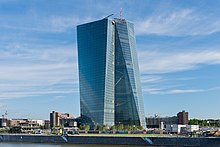
Frankfurt is home to two important central banks: the German Bundesbank and the European Central Bank (ECB).[61]
European Central Bank

The European Central Bank (Europäische Zentralbank) is one of the world's most important central banks. The ECB sets monetary policy for the Eurozone, consisting of 19
The city honors the importance of the ECB by officially using the slogan "The City of the Euro" since 1998.
Deutsche Bundesbank
The Deutsche Bundesbank (German Federal Bank), located in Ginnheim, was established in 1957 as the central bank for the Federal Republic of Germany. Until the euro (€) was introduced in 1999, the Deutsche Bundesbank was responsible for the monetary policy of Germany and for the German currency, the Deutsche Mark (DM). The Bundesbank was greatly respected for its control of inflation through the second half of the 20th century. Today the Bundesbank is an integral part of the European System of Central Banks (ESCB) which is formed by all 27 EU member states.
Commercial banks


In 2010, 63 national and 152 international banks had a registered office, including the headquarters of the major German banks, as well as 41 offices of international banks. in New York City) or "Bankfurt". 73,200 people were employed at banks in 2010.
- Deutsche Bank — Germany's largest commercial bank. It had 15% share of private customers and total assets of €1,900 billion in 2010. Deutsche Bank ranks among the 30 largest banks in the world and the ten largest banks in Europe.[62] Deutsche Bank is listed on the DAX, the stock market index of the 30 largest German business companies at the Frankfurt Stock Exchange. In November 2010 Deutsche Bank bought the majority of shares of competitor Postbank. Its headquarters are located at Taunusanlage in the financial district.
- Westend Tower and the City-Haus at Platz der Republik. The DZ Bank Group includes Union Investment, DVB Bank and Reisebank, which are also headquartered in Frankfurt.
- KfW Bankengruppe — Government-owned development bank formed in 1948 as part of the Marshall Plan. KfW provides loans for approved purposes at lower rates than commercial banks, especially to medium-sized businesses. With total assets of €507 billion (2017), it is Germany's third-largest bank. The KfW headquarters are located in the Westend district at Bockenheimer Landstraße and Senckenberganlage.
- Commerzbank — Germany's fourth-largest bank by total assets (2017). In 2009, Commerzbank merged with competitor Dresdner Bank, then the third-largest German bank. Due to the merger and the higher credit risks, Commerzbank was 25% nationalized during the Great Recession. It is listed in the DAX. Its headquarters are at Commerzbank Tower (259 meters), the second-tallest building in the EU, at Kaiserplatz.
- Sparkassen. Helaba is one of nine Landesbanken and is the fifth-largest in Germany. It is located in the 200-meter-tall Main Towerin the financial district, the only skyscraper in Frankfurt with an observation desk open to the public.
- DekaBank – DekaBank is the central asset manager of the Sparkassen in Germany. The headquarters of DekaBank are located at the Trianon skyscraper at Mainzer Landstraße.
- ING Diba Germany – Germany's largest direct bank, headquartered in Bockenheim
Other major German banks include
Many international banks have a registered or a representative office, e.g.,
Frankfurt Stock Exchange

The Frankfurt Stock Exchange (Frankfurter Wertpapierbörse) began in the ninth century. By the 16th century Frankfurt had developed into an important European hub for trade fairs and financial services. Today the Frankfurt Stock Exchange is by far the largest in Germany, with a turnover of more than 90 percent of the German
On 1 February 2012 European Commission blocked the proposed merger of Deutsche Börse and NYSE Euronext. "The merger between Deutsche Börse and NYSE Euronext would have led to a near-monopoly in European financial derivatives worldwide. These markets are at the heart of the financial system and it is crucial for the whole European economy that they remain competitive. We tried to find a solution, but the remedies offered fell far short of resolving the concerns."[63] European competition commissioner Joaquín Almunia said.
It is located downtown at the Börsenplatz. Deutsche Börse's headquarters are formally registered in Frankfurt, but it moved most of its employees to a high-rise called "The Cube" in Eschborn in 2010, primarily due to significantly lower local corporate taxes.
Frankfurt Trade Fair
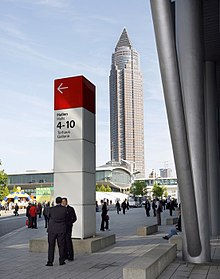
Frankfurt Trade Fair (Messe Frankfurt) has the third-largest exhibition site in the world with a total of 578,000 m2 (6,220,000 sq ft) . The trade fair premises are located in the western part between Bockenheim, the Westend and the Gallus district. It houses ten exhibition halls with a total of 321,754 m2 (3,463,330 sq ft) of space and 96,078 m2 (1,034,170 sq ft) of outdoor space.
Hosted in Frankfurt are the
Messe Frankfurt GmbH, the owner and operator company, organized 87 exhibitions in 2010, 51 thereof in foreign countries.[citation needed] It is one of the largest trade fair companies with commercial activities in over 150 countries.
Aviation
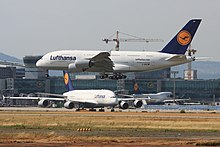
Frankfurt Airport is one of the busiest airports in the world and is also the single largest place of work in Germany with over 500 companies which employ 71,500 people (2010).[64]
Fraport is the owner and operator of Frankfurt Airport. It is the airport's second-largest employer (19,800 workers in 2010).[65] Fraport also operates other airports worldwide, e.g., King Abdulaziz International Airport in Jeddah, Jorge Chávez International Airport in Lima and Antalya Airport.
The largest company at Frankfurt Airport is Lufthansa, Germany's
Other industries
Accountancy and professional services
Three of the four largest international
Credit rating agencies
The three major international
Investment trust companies
DWS Investments is one of the largest
Management consultancies
Many of the largest international
Real estate services companies
Located in Frankfurt are the German headquarters of
Law firms
Frankfurt has the highest concentration of lawyers in Germany, with one lawyer per 97 inhabitants (followed by Düsseldorf with a ratio of 1/117 and Munich with 1/124) in 2005.[70]
Most of the large international
Advertising agencies
Although it is best known for its banks and financial institutions, Frankfurt is also a media hub. Around 570 companies of the advertising industry and 270 public relations companies are there.
According to a ranking of German
Food
Frankfurt is home to the German headquarters of
Automotive
The South-Korean
Construction
Some of the largest German construction companies have offices, e.g.,
Property and real estate
Frankfurt has Germany's highest concentration of homeowners. This is partly attributed to the financial sector, but also to its cosmopolitan nature, with expatriates and immigrants representing one-fourth of its population. For this reason, Frankfurt's property market often operates differently than the rest of the country where the prices are generally flatter.
Tourism
Frankfurt is one of Germany's leading tourist destinations. In addition to its infrastructure and economy, its diversity supports a vibrant cultural scene. This blend of attractions led 4.3 million tourists (2012) to visit Frankfurt.[72] The Hotels in central Frankfurt offer 34,000 beds in 228 hotels, of which 13 are luxury hotels and 46 are first-class hotels.[73]
Other


Frankfurt is home to companies from the chemical, transportation, telecommunication and energy industries. Some of the larger companies are:
- Industriepark Höchst — An , moved to Industriepark Höchst.
- Deutsche Bahn – Deutsche Bahn subsidiaries DB Stadtverkehr, DB Netz, DB Schenkerand the corporate development department of Deutsche Bahn are Frankfurt-based.
- Deutsche Telekom – Deutsche Telekom's subsidiary T-Systems is Frankfurt-based.
- COLT– telecommunications company with Frankfurt-based German headquarters
- Nintendo of Europe moved its headquarters from Großostheim to Frankfurt.[74]
- CenturyLink — internet service providerwith German headquarters in Frankfurt
- electronic communication, especially the Internet. It is home to DE-CIX, the world's largest internet exchange point.
- Mainova – The largest regional energy supplier in Germany with about one million customers in Hesse. It provides electricity, gas, heat and water. Its headquarters are Frankfurt-based.
In addition, several
Urban area (suburban) businesses
Within Frankfurt's urban area are several important companies.
The business hub of Eschborn is located right at Frankfurt's city limits in the west and attracts businesses with significantly lower
Offenbach am Main is home to the European headquarters of automobile manufacturer Hyundai Motor Company, to the German headquarters of automobile manufacturer Honda, to Honeywell Germany and to Deutscher Wetterdienst, the central scientific agency that monitors weather and meteorological conditions over Germany.
Two
Kronberg im Taunus is home of the German headquarters of automobile manufacturer Jaguar Cars as well as the German headquarters of Accenture.
Lufthansa Systems, a subsidiary of Lufthansa, is located in Kelsterbach.
The German headquarters of Thomas Cook Group are based in Oberursel.
Langen is home to Deutsche Flugsicherung, the German air traffic control.
International relations
Twin towns – sister cities
Frankfurt is twinned with:[76]
 Birmingham, West Midlands, England, United Kingdom (1966)
Birmingham, West Midlands, England, United Kingdom (1966) Budapest, Hungary (1990)
Budapest, Hungary (1990)- Val d'Oise, France (1967); formerly twinned with Nieder-Eschbach, incorporated into Frankfurt in 1972)[77]
 Dubai, Emirate of Dubai, United Arab Emirates (2005)
Dubai, Emirate of Dubai, United Arab Emirates (2005) Eskişehir, Eskişehir Province, Turkey (2013)
Eskişehir, Eskişehir Province, Turkey (2013) Granada, Granada Department, Nicaragua (1991)
Granada, Granada Department, Nicaragua (1991) Guangzhou, Guangdong, China (1988)
Guangzhou, Guangdong, China (1988) Kraków, Poland (1991)
Kraków, Poland (1991) Leipzig, Saxony, Germany (1990)
Leipzig, Saxony, Germany (1990) Lyon, France (1960)
Lyon, France (1960) Milan, Lombardy, Italy (1970)
Milan, Lombardy, Italy (1970) Philadelphia, Pennsylvania, United States (2015)
Philadelphia, Pennsylvania, United States (2015) Prague, Czech Republic (1990)
Prague, Czech Republic (1990) Tel Aviv, Gush Dan, Israel (1980)
Tel Aviv, Gush Dan, Israel (1980) Toronto, Ontario, Canada (1989)
Toronto, Ontario, Canada (1989)
Friendly cities
Frankfurt has friendly relations with:[76]
 Cairo, Egypt (1979)
Cairo, Egypt (1979)- Kanagawa, Japan (2011)
Cityscape
Landmarks
Römer

The former
Frankfurt Cathedral
Since the 18th century, St. Bartholomew's has been called Dom, although it was never a bishop's seat. In 1867 it was destroyed by fire and rebuilt in its present style. It was again partially destroyed in World War II and rebuilt in the 1950s. Its height is 95 meters. The cathedral tower has a viewing platform open to the public at a height of 66 meters, accessed through a narrow spiral staircase with 386 steps.
St. Paul's Church
St. Paul's was partially destroyed in World War II, particularly its interior, which now has a modern appearance. It was quickly and symbolically rebuilt after the war; today it is used mainly for exhibitions and events.
Archäologischer Garten Frankfurt
The Archaeological Garden contains small parts of the oldest recovered buildings: an ancient Roman settlement and the Frankfurt Royal Palace (Kaiserpfalz Frankfurt) from the sixth century. The garden is located between the Römerberg and the cathedral. It was discovered after World War II when the area was heavily bombed and later partly rebuilt. The remains were preserved and are now open to the public. From 2013 until 2015 an event building, the Stadthaus ("City house"), has been built on top of the garden, but it remains open to the public free of charge.
Haus Wertheim
Wertheim House is the only timbered house in the Altstadt district that survived the heavy bombings of World War II undamaged. It is located on the Römerberg next to the Historical Museum.
Saalhof
The
Eiserner Steg
The Eiserner Steg (Iron Bridge) is a pedestrian-only bridge across the Main that connects Römerberg and Sachsenhausen. It was built in 1868 and was the second bridge to cross the river. After World War II, when it was blown up by the Wehrmacht, it was quickly rebuilt in 1946. Today some 10,000 people cross the bridge on a daily basis.
Alte Oper
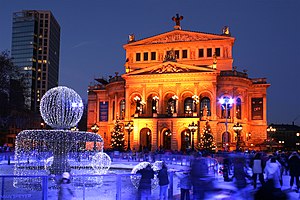
The
Public pressure led to its refurbishment and reopening in 1981. Today, it functions as a famous concert hall, while operas are performed at the "new" Frankfurt Opera. The inscription on the frieze of the Alte Oper says: "Dem Wahren, Schönen, Guten" ("To the true, the beautiful, the good").
Eschenheimer Turm
The Eschenheim Tower (Eschenheimer Turm) was erected at the beginning of the 15th century and served as a city gate as part of late-medieval fortifications. It is the oldest and most unaltered building in the Innenstadt district.
St. Catherine's Church (Katharinenkirche) is the largest Protestant church, dedicated to Catherine of Alexandria, a martyred early Christian saint. It is located downtown at the entrance to the Zeil, the central pedestrian shopping street.
Hauptwache
Although today
Central Station
Frankfurter Hof
The Frankfurter Hof is a landmark downtown hotel at Kaiserplatz, built from 1872 to 1876. It is part of
St. Leonhard
St. Leonhard, on the Main close to the bridge Eiserner Steg, is a Catholic late Gothic hall church, derived from a Romanesque style basilica beginning in 1425. It is the only one of nine churches in the Old Town that survived World War II almost undamaged. The parish serves the English-speaking community. The church has been under restoration from 2011 until 2019.[78]
Gründerzeit quarters
Around the city centre there are wide spread quarters full of Gründerzeit architecture. Buildings of that typ often sport richly-decorated façades in the form of Historicism such as Gothic Revival, Renaissance Revival, German Renaissance and Baroque Revival.
Around the city center of Frankfurt are several former independent villages, now part of the city, with
-
Höchst old town
20th-century architecture
- Frauenfriedenskirche and Holy Cross Church), both consecrated in 1929, are examples of early modernist church buildings during the time of the New Frankfurt.
- Großmarkthalle, built 1926–1928 as a part of the New Frankfurt-project, the former wholesale market hall was repaired after the second world war and integrated into the new seat of the European Central Bank between 2010 and 2014.
- Goethe House, rebuilt 1947. The birthplace of Johann Wolfgang von Goethe from 1749 was destroyed in World War II and then rebuilt true to the original.
- Junior-Haus, built 1951, an example of early post-World War II architecture located at Kaiserplatz.
- Bayer-Haus, built 1952, another example of early post-World War II architecture.
- Museum für angewandte Kunst, built 1985, designed by Richard Meier.
- US Army's V Corps and the Northern Area Command (NACOM) until 1995 when the US Army returned control of the IG Farben Building to the German government. It was purchased on behalf of the Goethe University Frankfurt by the state of Hesse. In October 2001 it became part of the Westend Campus of Goethe University.
21st-century architecture
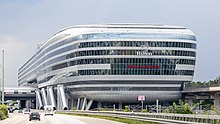
- Die Welle (The Wave), built 1998–2003, a complex of three wavelike-formed office buildings next to the Opernplatz.
- Alte Stadtbibliothek, rebuilt 2003–2005, reconstruction of the old public library house originally built 1820–1825.
- Palais Thurn und Taxis, rebuilt 2004–2009, reconstruction of a palace originally built 1731–1739.
- MyZeil, built 2004–2009, shopping mall at the Zeil with an imposing vaulted glass-structure.
- portmanteau of square and air), also known as Airrail Center Frankfurt, is a 660 m (2,165.35 ft) long and 45 m (147.64 ft) tall office building located at Frankfurt Airport. It was built from 2006 to 2011 on top of an existing railway station (Frankfurt Airport long distance Station) and has a connecting bridge to Terminal 1 for pedestrians. Its total of 140,000 m2 (1,506,947 sq ft) rentable floor space makes it Germany's largest office building.
Skyscrapers
Frankfurt is one of the few European cities with a significant number of skyscrapers, (buildings at least 150 m (492.13 ft) tall). It hosts 18 out of Germany's 19
The 18 skyscrapers are:
- Commerzbank Tower, 259.0 m (849.74 ft) – The EU's second-tallest building, the tallest building in Europe 1997–2003; Commerzbank headquarters.
- Messeturm, 256.5 m (841.54 ft) – The EU's third-tallest building, the tallest building in Europe 1990–1997; main tenant is Goldman Sachs (Germany).
- Westend Tower, 208.0 m (682.41 ft) – DZ Bankheadquarters
- Standard & Poor's(Germany) headquarters
- PricewaterhouseCoopers(Germany) headquarters
- ONE , 191 m (626.64 ft)
- Omniturm, 190.0 m (623.36 ft)
- Trianon, 186.0 m (610.24 ft) – DekaBank headquarters
- Seat of the European Central Bank, 185.0 m (606.96 ft) – European Central Bank headquarters
- Grand Tower, 179.9 m (590.22 ft) – Residential tower
- Opernturm, 170.0 m (557.74 ft) – UBS (Germany) headquarters
- Taunusturm, 170.0 m (557.74 ft)
- Silberturm, 166.3 m (545.60 ft) – Germany's tallest building 1978–1990, Main tenant is Deutsche Bahn.
- Westend Gate, 159.3 m (522.64 ft) – Germany's tallest building 1976–1978, Main tenant is Marriott Frankfurt Hotel.
- Deutsche Bank I, 155.0 m (508.53 ft) – Deutsche Bank headquarters
- Deutsche Bank II, 155.0 m (508.53 ft)
- Marienturm, 155.0 m (508.53 ft)
- Skyper, 153.8 m (504.59 ft) – Main tenant is DekaBank.
Other high-rise buildings include:
- Eurotower, 148.0 m (485.56 ft) – Former European Central Bank headquarters
- Frankfurter Büro Center, 142.4 m (467.19 ft) – Main tenant is Clifford Chance (Germany).
- City-Haus, 142.1 m (466.21 ft) – Main tenant is DZ Bank.
- Gallileo, 136.0 m (446.19 ft) – Main tenant is Commerzbank.
History of high-rise buildings

For centuries,
The first high-rise building boom came in the 1970s when
None of the buildings constructed during the 1980s surpassed Silberturm. The most famous buildings from this decade are the Deutsche Bank Twin Towers at Taunusanlage, both 155.0 meters tall.
The 1990s featured a second wave. Messeturm, built on the trade fair site, reached a height of 256.5 meters (842 ft) and became the tallest building in Europe by 1991. It was overtaken by the 259 m-high (850 ft) Commerzbank Tower in 1997. Other tall buildings from this decade are Westendstrasse 1 (208 meters (682 ft)), Main Tower (200 meters (660 ft)) and Trianon (186 meters (610 ft)).
In 21st-century Frankfurt, more high-rise buildings and skyscrapers (e.g., Skyper, Opernturm, Tower 185, Seat of the European Central Bank, Taunusturm) emerged, but none have surpassed Commerzbank Tower.
Other tall structures

- Europaturm — The Europe Tower is a telecommunications tower, also known as the Frankfurt TV Tower, built from 1974 to 1979. With a height of 337.5 meters it is the tallest tower and the second tallest structure in Germany after the Fernsehturm Berlin. It was open to the public until 1999, with an entertainment establishment in the revolving top. It is normally referred to by locals as the "Ginnheimer Spargel" (Ginnheim Asparagus), but stands a few meters within Bockenheim district.
- grain silo built from 1959 to 1961 and owned by Henninger Brewery. It was the highest structure until 1974. The Henninger Tower had two rotating restaurants at the height of 101 and 106 meters and an open-air observation deck at the height of 110 meters. The tower closed to the public in October 2002 and was demolished in 2013 to be replaced by a 140 m (459 ft) tall residential tower, which is externally inspired by the old Henninger Turm. The cornerstone for this project was laid in June 2014 and construction was completed in summer 2017. The new tower offers 207 luxury flats[83] and houses the non-rotating restaurant "Franziska". From 1962 to 2008 a famous yearly cycling racewas named after the tower, the "Radrennen Rund um den Henninger Turm" (Cycling race around Henninger Tower). The now-renamed race is still a yearly event.
- Goetheturm – The Goethe Tower was a 43 m-high (141 ft) tower on the northern edge of the Frankfurt City Forest in Sachsenhausen. It was the fifth tallest wood construction structure in Germany. It was built in 1931 and was a popular place for day-trippers until it burned down in 2017. A faithful reconstruction has been opened to the public on 12 October 2020, exactly three years after the original's destruction.[84]
Shopping streets

- NewYorker. In 2009 a new shopping mall named MyZeil opened there with nearly 100 stores and chains like Hollister. Three more shopping malls occupy the Zeil: UpperZeil (replacing the Zeilgalerie, which was demolished in 2016), Galeria Kaufhof and Karstadt, as well as large fashion retail clothing stores from Peek & Cloppenburg and C&A. During the month before Christmas, the extended pedestrian-only zone is host to Frankfurt Christmas Market, one of the largest and oldest Christmas markets in Germany.
- . It is located between the financial district and downtown, running from Goetheplatz to Opernplatz.
- Porsche Design) have moved here due to the lack of space in the neighboring Goethestraße, displacing old, established restaurants, butchers and delicatessens.
- Berger Straße – Frankfurt's longest shopping street. It starts in the city center, runs through Bornheim and ends in Seckbach. The street is less crowded than the Zeil and offers a greater variety of smaller shops, restaurants and cafés.
- Leipziger Straße – Central shopping street in the Bockenheim district starting at Bockenheimer Warte going towards West. High density of shops for daily needs.
- Braubachstraße – In the Altstadt district, close to the historic sites of the city, offers a large variety of art galleries, second-hand bookshops and antique shops.
- Münchener Straße – In the Bahnhofsvierteldistrict, located between the central station and Willy-Brandt-Platz, is the most multicultural shopping street with many shops selling imported products mainly from Turkey, the Middle East and Asia.
- Kaiserstraße – One of the best-known streets and considered one of the most beautiful because of its amount of Gründerzeit-style buildings. It runs parallel to Münchener Straße from the central station to the financial district. Kaiserstraße is still a synonym for Frankfurt's Red-light district although sex-oriented businesses moved to neighboring streets such as Taunusstrasse in the 1990s. Today Kaiserstraße houses many small shops, restaurants and cafés.
- Kleinmarkthalle – (literally: Small Market Hall) is a market hall close to Konstablerwache square offering fresh food and flowers. In addition to regional delicacies like green sauce imported goods are offered. The Kleinmarkthalle is the largest public marketplace in Frankfurt.
Green city

With a large forest, many parks, the Main riverbanks and the two botanical gardens, Frankfurt is considered a "green city": More than 50 percent of the area within the city limits are protected green areas.[85]
- Frankfurter Grüngürtel – The Green Belt is a ring-shaped public green space around the city. With 8,000 Fechenheim). The Green Belt is a protected areawhich means that housing is not allowed. The Green Belt was formally created in 1991 with its own constitution.
- Mainuferpark – The Mainuferpark (Main Riverbanks Park) is the common term to describe the inner-city Main riverbanks. It is an auto-free zone with large green areas that is popular with strollers and tourists, especially in the summertime, when it can become crowded. The southern riverbank, which continues further to Offenbach am Main and Hanau, offers the best skyline views. The northern riverbank ends in the west at the former Westhafen (West Harbor, a residential housing area) and is growing to the east: A former industrial-used area between the new Seat of the European Central Bank and the Osthafen (East Harbor) has become a park named Hafenpark (Harbor Park), which offers outdoor courts for basketball, soccer and a skatepark.
- Wallanlagen – The Wallanlagen (former ramparts) relate to the former ring-shaped city wall fortifications around the Altstadt and the Innenstadt district (abolished 1804–1812), now a series of parks. Building is not allowed, with a few exceptions, the most famous being the Alte Oper (built 1880) at the Opernplatz. The part between the northern Main riverbank and the Opernplatz, referred to officially as Taunusanlage and Gallusanlage, is locally known as "Central Park" (a reference to the famous park in Manhattan), because of the skyscrapers which stand on both sides.
- Nizza Park – At the juncture of the northern Main riverbank and the Wallanlagen is a famous small park called Nizza. The name of the park recalls Mediterranean floragrow there and can survive outside during the winter.
- Garten des Himmlischen Friedens – "Garden of Heavenly Peace", named after the Tiananmen Gate in Beijing, is a Chinese-styled park in the Nordend district and part of the larger Bethmannpark. It contains Chinese buildings, with building materials imported from China and built by Chinese workers in the 1980s. Hosts traditional Chinese plants and herbs.
- Other parks – The largest parks are the Niddapark (168 ha), the Ostpark (32 ha) and the Grüneburgpark (29 ha).
Culture
Museums


With more than 30 museums, Frankfurt has one of the largest variety of museums in Europe. Most museums are part of the Museumsufer, located on the front row of both sides of the Main riverbank or nearby, which was created on an initiative by cultural politician Hilmar Hoffmann.[86]
Ten museums are located on the southern riverbank in Sachsenhausen between the Eiserner Steg and the Friedensbrücke. The street itself, Schaumainkai, is partially closed to traffic on Saturdays for Frankfurt's largest flea market.
- Deutsches Architekturmuseum (German Architecture Museum)
- Deutsches Filmmuseum (German Film Museum)
- Deutsches Romantik-Museum
- Frankfurter Ikonenmuseum (Icon Museum Frankfurt)
- Liebieghaus (Museum of sculptures)
- Museum Angewandte Kunst (Museum of Applied Arts)
- Museum Giersch (Museum for Regional Art)
- Museum für Kommunikation (Museum of Communications)
- Museum der Weltkulturen (Museum of World Cultures)
- Städel, one of the most famous art museums in Germany
- Museum für elektronische Musik (Museum of Modern Electronic Music)
- Bibelhaus Erlebnis Museum (Bible House Experience Museum)
Two museums are located on the northern riverbank:
- Jüdisches Museum Frankfurt (Jewish Museum Frankfurt)
- Historisches Museum Frankfurt(Historical Museum Frankfurt)
Not directly located on the northern riverbank in the Altstadt district are:
- Museum für Moderne Kunst (Museum of Modern Art)
- Schirn Kunsthalle Frankfurt (Schirn Art Gallery Frankfurt)
- Frankfurter Kunstverein (Art Association Frankfurt)
- Museum Judengasse (Jews' Alley Museum)
- Goethe-Haus (Goethe House)
- Archäologisches Museum Frankfurt (Archaeological Museum Frankfurt)
- Caricatura Museum für Komische Kunst (Caricatura Museum of Comic Art)
- Dommuseum Frankfurt (Frankfurt Cathedral Museum)
Another important museum is located in the Westend district:
- Naturmuseum Senckenberg (Senckenberg Natural History Museum), the second-largest natural history museum in Germany
Other museums are the Dialogmuseum (Dialogue Museum) in the
Performing arts
Music
Venues

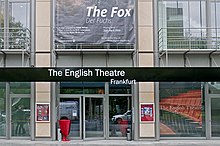
- Schauspiel Frankfurt – Theater at Willy-Brandt-Platzin the financial district, next to the Frankfurt Opera.
- hr-Sinfonieorchesterin German) – one of the top symphony orchestras in the world
- Frankfurt Trade Fair. It is mostly used for concerts, exhibitions or sport events and can accommodate up to 13,500.
- Deutsche Bank Park – Frankfurt's largest sports stadium and the seventh largest in Germany. It is located in the Frankfurt City Forest near Niederrad. It is primarily used for soccer and concerts with a capacity up to 58,000. It opened in 1925 and underwent several major reconstructions. Locals still prefer to call the stadium by its traditional name, Waldstadion (Forest Stadium). Home to Eintracht Frankfurt.
- Alte Oper – A major concert hall.
- Jahrhunderthalle – Century Hall is a large concert and exhibition hall in Unterliederbach district. Sometimes referred to as "Jahrhunderthalle Höchst", because it was built to celebrate the 100th anniversary of the chemical company Hoechst AGin 1963.
- The English Theatre – Located on the ground floor of the Gallileo high-rise building, this is the largest English theater in continental Europe. It was established in 1979.
- Tigerpalast – Tiger Palace is a varieté near the Zeil. It was established in 1988 and houses the famous Tiger-Restaurant which was awarded a Michelin star.
- Künstlerhaus Mousonturm – House of Artists Mouson Tower has a smaller budget than traditional theaters and uses more unconventional performing methods. It is located in an old factory in the Ostend district.
- Die Schmiere – The Grease is a cabaret and Frankfurt's oldest privately owned theater. It is located in the Karmeliterkloster in the Altstadt district. According to its own advertising, it is the worst theater in the world.
- Die Komödie – The Comedy is a boulevard theater near downtown Frankfurt's Willy-Brandt-Platz.
Botanical gardens

Frankfurt is home to two major botanical gardens:
- Palmengarten – Located in the Westend district, it is Hesse's largest botanical garden, covering 22 ha (54 acres). It opened to the public in 1871. The botanical exhibits are organized according to their origin in free-air or in greenhouses that host tropical and subtropical plants, hence the name "Palm Garden".
- Mediterranean, and North America and the systematic and ecological collection includes crop plants, endangered species, ornamental plants, roses, and the Neuer Senckenbergischer Arzneipflanzengarten (New Senckenberg Medicinal Plant Garden), which measures 1,200 m2 (13,000 sq ft). The Botanical Garden, Palmengarten, Grüneburgparkcollectively form the largest inner-city green area.
Foreign culture
- Letizia, Princess of Asturias. It is located in the so-called Amerika-Haus.
- Institut Français – A French public industrial and commercial organization (EPIC), started in 1907 by the Ministry of Foreign Affairs for promoting French, francophone as well as local cultures around the world. The French Institute works closely with the French cultural network abroad consisting of more than 150 branches and nearly 1,000 branches of the Alliance française around the world.
- Istituto Italiano di Cultura – A worldwide non-profit organization created by the Italian government. It promotes Italian culture and is involved in the teaching of the Italian language; there are 83 Italian Cultural Institutes throughout major cities around the world.
- Confucius Institute – A non-profit public educational organization affiliated with the Ministry of Education of the People's Republic of China, whose aim is to promote Chinese language and culture, support local Chinese teaching internationally, and facilitate cultural exchanges. There are over 480 Confucius Institutes worldwide.
- Central and Eastern European Online Library – CEEOL is an online archive providing access to full-text articles from humanities and social science scholarly journals on Central, Eastern and South-Eastern European topics. Subject areas include anthropology, culture and society, economy, gender studies, history, Judaic studies, fine arts, literature, linguistics, political sciences and social sciences, philosophy and religion. CEEOL is operated by Questa.Soft GmbH.
Festivals

- Museumsuferfest – Museums Riverbank Festival is one of Germany's biggest cultural festivals, attracting more than 3 million visitors over three days at the end of August along the Main riverbank downtown. The 20 museums there open far into the night. It offers live music, dance shows, booths for crafts, jewelry, clothes and food stands from around the world.
- Dippemess – Frankfurt's oldest folk festival is the Festival of Stoneware, which takes place semi-annually around Easter and the end of September in the eastern area. "Dippe" is a regional Hessian dialect word meaning "pot" or "jar" which would not be understood in most other German regions. Mentioned for the first time in the 14th century as an annual marketplace it is now more of an amusement park. The name of the festival derives from its original purpose when it was a fair where traditionally crafted jars, pots and other stoneware were on offer.

- Luminale — The "festival of light" has taken place biannually since 2000, parallel to the Light + building exhibition at the trade fair. Many buildings are specially lit for the event. In 2008, more than 220 light installations could be seen, attracting 100,000 visitors.
- Wäldchestag – Day of the forest is known as a regional holiday because until the 1990s it was common that Frankfurt's shops were closed on this day. The festival takes place over four days after Pentecost with the formal Wäldchestag on Tuesday. Its unique location is in the Frankfurt City Forest, south-west of downtown in Niederrad. "Wäldches" is a regional dialect of the German word "Wäldchen", meaning "small forest".
- Nacht der Museen – Night of the museums takes place every year in April or May. 50 museums in Frankfurt and in the neighboring city of Offenbach am Main are open until 2:00 am surrounded by special music events, dance performances, readings and guided tours. A free shuttle operates between the museums. In 2010, approximately 40,000 visitors attended.
- Nacht der Clubs – Night of the clubs is an event similar to Nacht der Museen: On one night as many as 20 clubs can be visited with a single ticket for €12. Usually, club-door policies are loosened to attract new customers. A free shuttle runs between the clubs. 15,000 people participated in 2008.
- Wolkenkratzer Festival — The Skyscraper Festival is unique in Germany. It takes place irregularly, lately in May 2013, and attracted around 1.2 million visitors. For two days most skyscrapers are open to the public. Sky-divers, base jumpers, fireworks and laser shows are extra attractions.
Nightlife
Frankfurt offers a variety of restaurants, bars, pubs and clubs. Clubs concentrate in and around downtownand in the Ostend district, mainly close to Hanauer Landstraße. Restaurants, bars and pubs concentrate in Sachsenhausen, Nordend, Bornheim and Bockenheim.
In
Among the most popular active rock and pop concert venues is the Batschkapp in Seckbach, which opened in 1976 as a center for autonomous and left-wing counterculture. Further popular active clubs and music venues include the Velvet Club, The Cave, Cooky's, Nachtleben, Silbergold, Zoom, Tanzhaus West and the Yachtclub.
Domestic culture
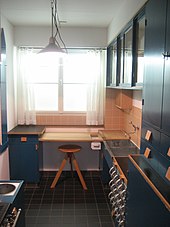
- Frankfurt kitchen – Designed originally in 1926 for the New Frankfurt-project and built in some 10,000 units, the kitchen became a milestone in domestic architecture, considered the forerunner of modern fitted kitchens.
- Frankfurt cupboard – The Baroque Frankfurt-style cupboards were used to store the family linen, one of them by Goethe's father, who took one cupboard to Rome. The most luxurious versions have wave-shaped parts, some are made of solid cherry wood inlaid with plumwood.
Culinary specialties
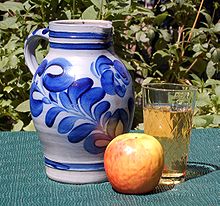
- Apfelwein – Apple wine or hard cider is regionally known as "Ebbelwoi", "Äppler" or "Stöffsche". It has an alcohol content of 5.5%–7% and a tart, sour taste. It is traditionally served in a glass, typically decorated with lozenges, called "Geripptes", a full glass is then called "Schoppen". Apfelwein is also available in a stoneware jar locally known as "Bembel". A group normally orders a "Bembel" and shares the contents. Apfelwein can be ordered as "sauergespritzer", which is apfelwein blended with 30% mineral water or as "süssgespritzer", which is Apfelwein blended with lemon soda, orange soda or fresh-pressed apple juice (lemon soda being the most common). Most of the pubs which serve Apfelwein are located in Sachsenhausen, which is therefore known as "Ebbelwoi district". Due to its national drink Frankfurt is sometimes called "Big Ebbel" (pronunciation with Hessian dialect), an homage to Big Apple, the famous nickname of New York City.
- Grüne Soße – Green sauce is a sauce made with hard-boiled eggs, oil, vinegar, salt and a generous amount of seven fresh herbs, namely borage, sorrel, garden cress, chervil, chives, parsley and salad burnet. Variants, often due to seasonal availability include dill, lovage, lemon balm and spinach. Original green sauce Frankfurt-style is made of herbs that were gathered only on fields within the city limits.
- Frankfurter Würstchen – "short Frankfurter" is a small sausage made of smoked pork. They are similar to hot dogs. The name Frankfurter Würstchen has been trademarked since 1860.
- Frankfurter Rindswurst – Sausage made of pure beef.
- Frankfurter Rippchen – Also known as Rippchen mit Kraut, this is a traditional dish which consists of cured pork cutlets, slowly heated in sauerkraut or meat broth, and usually served with sauerkraut, mashed potatoes and yellow mustard.
- sour milk cheese (similar to Harzer) and a culinary specialty in the Rhine Main Region. The traditional way of producing it is by hand. When it is topped with chopped onions it becomes "Handkäs mit Musik" (with music) because the onions are supposed to stimulate flatulence.
- Frankfurter Kranz – Cake speciality believed to originate from Frankfurt.
- Bethmännchen – "A little Bethmann" is a pastry made from marzipan with almond, powdered sugar, rosewater, flour, and egg. It is usually baked for Christmas.
Quality of life
In a 2001 ranking by the
Frankfurt was voted the seventh in the
Frankfurt consistently has the highest levels of crime per 100,000 inhabitants in Germany (15.976 crimes per annum in 2008) and is therefore dubbed the German "crime capital".[93] However, this statistic is often criticized[citation needed] because it ignores major factors: It is calculated based on the administrative 680,000-inhabitant figure while the urban area has 2.5 M inhabitants and on weekdays adds another million people[citation needed] (not counting the 53 million passengers passing through the airport each year). The rate for personal safety-relevant crimes such as murder, manslaughter, rape or bodily harm, is 3.4 percent, placing Frankfurt twelfth in the ranking (related to the official 680,000-inhabitant figure) or number 21 (related to the one-million-figure).[94] In 2018, the state of Hesse, where Frankfurt is located, was ranked the third-safest state in Germany.[95]
Transport
Airports
Frankfurt Airport

The city can be accessed from around the world via
A third terminal is being constructed (planned to open in 2026). The third terminal will increase the capacity of the airport to over 90 million passengers per year.[96]
The airport can be reached by car or bus and has two railway stations, one for regional and one for long-distance traffic. The
Frankfurt Hahn Airport
Despite the name,
Frankfurt Egelsbach Airport
Frankfurt Egelsbach Airport (Flugplatz Frankfurt-Egelsbach) is a busy general aviation airport located south-east of Frankfurt Airport, near Egelsbach.
Roads

Frankfurt is a traffic hub for the German motorway (
The streets of central Frankfurt are usually congested with cars during rush hour. Some areas, especially around the shopping streets Zeil, Goethestraße and Freßgass, are pedestrian-only streets.
Railway stations
Frankfurt Central Station

(Frankfurt Hauptbahnhof, often abbreviated as Frankfurt (Main) Hbf or F-Hbf) is the largest railway station in Germany by railway traffic. By daily passenger volume, it ranks second together with
Frankfurt Airport stations

Frankfurt Airport can be accessed by two railway stations:
Frankfurt South station
Frankfurt's third long-distance station is
Messe stations
The
Konstablerwache station and Hauptwache station
Two other major downtown railway stations are Konstablerwache and Hauptwache, located on each end of the Zeil. They are the main stations to change from east-to-west-bound S-Bahn trains to north-to-south-bound U-Bahn trains. Konstablerwache station is the second-busiest railway station regarding daily passenger volume (191,000) after the central station. The third-busiest railway station is Hauptwache station (181,000).[99][100]
Frankfurt West Station

This Station, located in Bockenheim, is served by north-heading Long-Distance ICE trains, multiple regional trains, and four commuter S-Bahn lines (S3, S4, S5, S6). Additionally, it is an important terminal stop for three "Metrobus" lines (M32, M36, M73).
Coach stations
There are three stations for intercity bus services in Frankfurt: one at the south side of the Central Station, one at the Terminal 2 of the airport and another one at Stephanstraße.[101]
Public transport

The city has two rapid transit systems: the U-Bahn and the S-Bahn, as well as an above-ground tram system. Information about the U- and S-Bahn can be found on the website of the RMV.[102]
S-Bahn
Nine
U-Bahn

The
Tram
Frankfurt has ten tram lines (11, 12, 14 to 21), with trams arriving usually every 10 minutes. Many sections are served by two lines, combining to run at 5-minute intervals during rush-hour. Trams only run above ground and serve more stops than the U-Bahn or the S-Bahn.
Bus
A number of bus lines complete the Frankfurt public transport system. Night buses replace U-Bahn and tram services between 1:30 am and 3:30 am.[103] The central junction for the night bus service is at the downtown square of Konstablerwache, where all night bus lines start and end.
Taxis
Bicycles
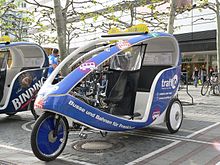
Deutsche Bahn makes bicycles available for hire through their Call a Bike service. The bicycles are stationed all over the city, including at selected railway stations. They can easily be spotted because of their eye-catching silver-red color. To rent a specific bike, riders either call a service number to get an unlock code or reserve the bike via the smartphone application. To return the bike, the rider locks it within a designated return area (and calls the service number, if not booked via the app).[106]
Nextbike also makes bicycles available for hire in Frankfurt. They are stationed all over the city. These can be spotted with their blue color scheme.
Cycle rickshaws (velotaxis), a type of tricycle designed to carry passengers in addition to the driver, are also available. These are allowed to operate in pedestrian-only areas and are therefore practical for sightseeing.
Frankfurt has a network of cycle routes. Many long-distance bike routes into the city have cycle tracks that are separate from motor vehicle traffic. A number of downtown roads are "bicycle streets" where the cyclist has the right of way and where motorized vehicles are only allowed access if they do not disrupt the cycle users. In addition, cyclists are allowed to ride many cramped one-way streets in both directions. As of 2015[update], 15 percent of citizens used bicycles.[107]
E-Scooters
Since 15 June 2019, the use of
Public institutions

European Insurance and Occupational Pensions Authority
The
Federal Financial Supervisory Authority
Frankfurt is one of two locations of the German Federal Financial Supervisory Authority (Bundesanstalt für Finanzdienstleistungsaufsicht, short: BaFin). The BaFin is an independent federal institution and acts as Germany's financial regulatory authority.
International Finance Corporation
Frankfurt is home to the German office of the International Finance Corporation (IFC), which is part of the World Bank Group. The IFC promotes sustainable private sector investment in developing countries.
German National Library
Frankfurt is one of two sites of the German National Library (Deutsche Nationalbibliothek), the other being Leipzig. The Deutsche Nationalbibliothek is the largest universal library in Germany.[citation needed] Its task, unique in Germany, is to collect, permanently archive, comprehensively document and record bibliographically all German and German-language publications from 1913 on, foreign publications about Germany, translations of German works and the works of German-speaking emigrants published abroad between 1933 and 1945, and to make them available to the public.[109]
Consulates
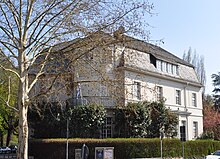
As a profoundly international city, Frankfurt hosts 92 diplomatic missions (consulates and
Courts
Several courts are located in Frankfurt, including:
- Hessisches Landesarbeitsgericht (Hessian State Employment Court)[111]
- Oberlandesgericht Frankfurt (Higher Regional Court Frankfurt)[112]
- Landgericht Frankfurt (Regional Court Frankfurt)[113]
- Amtsgericht Frankfurt (Local Court Frankfurt)[114]
- Sozialgericht Frankfurt (Social Court Frankfurt)[115]
- Arbeitsgericht Frankfurt (Employment Court Frankfurt)[116]
- Verwaltungsgericht Frankfurt (Administration Court Frankfurt)[117]
Education and research
Universities and schools
Frankfurt hosts two universities and several specialist schools. The two business schools are Goethe University Frankfurt's Goethe Business School and Frankfurt School of Finance & Management.
Johann Wolfgang Goethe University
The oldest and best-known university is the
Frankfurt University of Applied Sciences
The
Frankfurt School of Finance and Management
The city is also home to a business school, Frankfurt School of Finance & Management, formerly known as the Hochschule für Bankwirtschaft (Institution of Higher Learning for Banking Economics), with its new campus near Deutsche Nationalbibliothek U-Bahn stop (recently moving from its previous location in the Ostend (Eastend) neighborhood). In 2001, it became a specialist institution for Economics and Management, or FOM. Frankfurt School is consistently ranked among the best business schools in the world, attributed to its high research output and quality of undergraduate and graduate training.[118]
Städelschule
Frankfurt has the State Institution of Higher Learning for Artistic Education known as the Städelschule, founded in 1817 by Johann Friedrich Städel. It was taken over by the city in 1942 and turned into a state art school.
Music schools and conservatory
Music institutions are the Frankfurt University of Music and Performing Arts, and the Hoch Conservatory (Dr. Hoch's Konservatorium) which was founded in 1878. The International Ensemble Modern Academy is a significant institution for the study of contemporary music.[119]
Other notable schools
The Sankt Georgen Graduate School of Philosophy and Theology (German:Philosophisch-Theologische Hochschule Sankt Georgen), a private institution with membership in the German Jesuit Association, has been located in Sachsenhausen since 1950.
Education and media
Frankfurt schools rank among the best-equipped schools nationwide for the availability of PCs and other media facilities.[
Research institutes

The city is home to three
The Frankfurt Institute for Advanced Studies, sponsored by several institutional and private sources, is involved in theoretical research in physics, chemistry, neuroscience, and computer science.
Frankfurt is host to the Römisch-Germanische-Kommission (RGK), the German Archaeological Institute branch for prehistoric archeology in Germany and Europe. The RGK is involved in a variety of research projects. Its library, with over 130,000 volumes, is one of the largest archeological libraries in the world.[citation needed]
Goethe University and Frankfurt University of Applied Sciences are involved in the Hessian Center for Artificial Intelligence ("hessian.AI").
Trade unions and associations
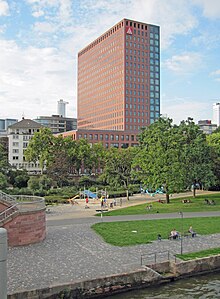
Frankfurt is home to multiple trade unions and associations, including:
- Gutleutvierteldistrict
- IG Bauen-Agrar-Umwelt, a union for construction and engineering workers,
- Gewerkschaft Erziehung und Wissenschaft, a union for teachers
- train drivers
Trade associations include:
- Verband der Elektrotechnik, Elektronik und Informationstechnik(Electrotechnical, Electronic and Information Technology Association)
- DECHEMA Gesellschaft für Chemische Technik und Biotechnologie (Applied Chemistry and Biotechnology Association)
- Börsenverein des Deutschen Buchhandels, which organizes the Frankfurt Book Fair
- Bundesverband des Deutschen Versandhandels (German Mail Order Industry Association)
- Verband der Chemischen Industrie (Chemical Industry Association)
- Verband der Photoindustrie (Photography Industry Association)
- Verband Deutscher Maschinen- und Anlagenbau (German Machine and Equipment Building Association)
- Verband der Köche Deutschlands (German Cooks Association)
Media
Newspapers

Two important daily newspapers are published. The conservative Frankfurter Allgemeine Zeitung, also known as FAZ, was founded in 1949 and is the German newspaper with the widest circulation outside of Germany, with its editors claiming to deliver the newspaper to 148 countries every day. The FAZ has a circulation of over 380,000 copies daily. The other important newspaper, the Frankfurter Rundschau, was first published in 1945 and has a daily circulation of over 181,000.
Magazines
Several magazines also originate from Frankfurt. The local Journal Frankfurt is the best-known magazine for events, parties, and "insider tips". Öko-Test is a consumer-oriented magazine that focuses on ecological topics. Titanic is a well-known and often criticized satirical magazine with a circulation of approximately 100,000.
Radio and TV
Frankfurt's first radio station was the Südwestdeutsche Rundfunkdienst AG (Southwest German Broadcast Service), founded in 1924. Its successor service is the public broadcaster Hessischer Rundfunk (Hessian Broadcast Service). It is located at the "Funkhaus am Dornbusch" in the Dornbusch district and is one of the most important radio and television broadcasters in Hesse, with additional studios in Kassel, Darmstadt and Fulda.
Other radio broadcasters include Main FM and Radio X.
From August 1945 to October 2004, the American Forces Network (AFN) had broadcast from Frankfurt (AFN Frankfurt). Due to troop reductions the AFN's location has been closed with AFN now broadcasting from Mannheim.
News agency
Frankfurt is home to the German office of Reuters, a global news agency. Associated Press and US-based international news agency Feature Story News have bureaux in Frankfurt.
Sports
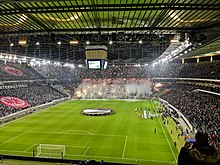
Frankfurt is home to several professional sports teams. Some of them have won German Championships. E.g. the
- Skyliners Frankfurt, Basketball
- Frankfurt Galaxy, American football
- Frankfurt Universe, American football
- Frankfurt Pirates, American football
- Frankfurt Sarsfields GAA, Gaelic football
- Frankfurt Lions (until 2010), Ice hockey
- Löwen Frankfurt (since 2010), Ice hockey
- SC 1880 Frankfurt, Rugby union
- Eintracht Frankfurt, Football (women)
- Eintracht Frankfurt, Football (men)
- FSV Frankfurt, Football (men)
- Rot-Weiss Frankfurt, Football
- Frankfurter FC Germania 1894, Football
Frankfurt is host to the
Sights in the Frankfurt Rhein-Main area
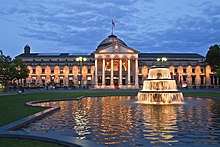


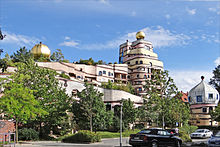
Besides the tourist attractions in central Frankfurt many internationally famous sites are within 80 km (50 mi) of the city, such as:
North
- Taunus mountain range
- Roman Empire Army Camp Saalburg
- Limes (former northern border of the Roman Empire)
- Bad Homburg vor der Höhe with its famous casino
- Bad Nauheim Elvis Presley memorial
- Hessenpark
West
- Rüdesheim
- Rheingau
- Eberbach Monastery (the original movie set of the film The Name of the Rose)
- Rhine Valley
- River Rhine
- Rheinhessen wine region
East
- Leather Museum Offenbach
- Grimm BrothersSummer Festival
- German Fairy Tale Route
- Spessart
South
- Darmstadt with the Art Nouveau Mathildenhöhe
- Waldspirale
- The former private chapel of the last Tsar of Russia
- Vortex Garden
- Odenwald
- Bergstrasse
- Vineyards at Heppenheim
- Frankenstein Castle
- Heidelberg
See also
- Frankfurt School
- List of people from Frankfurt
- Mayor of Frankfurt-am-Main
- List of cities in Hesse by population
- List of cities in Germany by population
Notes
References
- Citations
- Süddeutsche.de (in German). 11 November 2022. Archivedfrom the original on 11 November 2022. Retrieved 11 November 2022.
- ^ Regional Monitoring 2015. Facts and Figures – FrankfurtRheinMain Metropolitan Region Archived 31 January 2017 at the Wayback Machine Retrieved 18 January 2017
- ^ The FrankfurtRheinMain region – facts and figures Archived 31 January 2017 at the Wayback Machine Retrieved 18 January 2017
- Hessisches Statistisches Landesamt. June 2023.
- ^ Hessian: Frangford am Maa, pronounced [ˈfʁɑŋfɔɐ̯t am ˈmãː]
- ^ Keil, Carsten. "Frankfurter Aussprachewörterbuch". Archived from the original on 13 March 2023. Retrieved 13 March 2023.
- ^ "Worlds Wealthiest Cities 2023". Henley & Partners. Retrieved 9 January 2024.
- ^ a b Internetredaktion (23 May 2012). "Bundesbank: Bankenplatz Frankfurt" (PDF) (in German). Bundesbank.de. Archived from the original (PDF) on 1 January 2011.
- ^ "The World According to GaWC Archived 30 November 2012 at the Wayback Machine". GaWC. Retrieved 4 November 2014.
- ^ Bahnhof.de Frankfurt Hbf Archived 15 February 2012 at the Wayback Machine. Retrieved 27 September 2011.
- ^ Strassenwaerter Archived 2 May 2005 at the Wayback Machine
- ^ "Mercer's Survey 2011". Mercer. 29 November 2011. Archived from the original on 2 May 2014.
- ^ "World's most expensive place to live is..." The Economist. Archived from the original on 19 February 2012.
- ^ Dovid Solomon Ganz, Tzemach David (part 2), Warsaw 1859, p. 13b (Hebrew); Polish name of book: Cemahc Dawid; cf. J.M. Wallace-Hadrill, Fredegar and the History of France, University of Manchester, n.d. pp. 536–538.
- ISBN 978-0-7864-2248-7. Archivedfrom the original on 22 July 2011. Retrieved 23 July 2009.
- ^ "LEIZA: The onset of urbanisation in the Rhine-Main region 6,000 years ago".
- ^ Rolf Grosse (2014). Du royaume franc aux origines de la France et de l'Allemagne 800–1214. Presses Universitaires du Septentrion. p. 47.
- ^ Mohr, Albert Richard (1967). "Abel Seyler und seine Verdienste um das Frankfurter Theaterleben". Frankfurter Theater von der Wandertruppe zum Komödienhaus: ein Beitrag zur Theatergeschichte des 18. Jahrhunderts. Frankfurt am Main: Kramer. pp. 66–81.
- ^ Chronology: Emergence of a Modern City 1866–1945 Archived 19 July 2011 at the Wayback Machine. Retrieved 10 June 2010.
- ^ "French march into Germany". The Times. 7 April 1920. p. 10. "The French commander issued a notice to the public informing them that the occupation was consequent upon the German advance in the Ruhr contrary to the Peace Treaty."
- ^ a b "Jüdische Geschichte". frankfurt-tourismus.de. Archived from the original on 20 September 2022. Retrieved 17 September 2022.
- ^ "Frauenjugendgefängnis Frankfurt-Preungesheim". Bundesarchiv.de (in German). Retrieved 24 November 2023.
- ^ "Lager für Sinti und Roma Frankfurt am Main". Bundesarchiv.de (in German). Retrieved 24 November 2023.
- ISBN 978-0-253-06089-1.
- ^ "Anlage zu § 1. Verzeichnis der Konzentrationslager und ihrer Außenkommandos gemäß § 42 Abs. 2 BEG" (in German). Archived from the original on 23 April 2009. Retrieved 24 November 2023.
- ISBN 9780811701570.
- ^ Goitein, S.D. A Mediterranean Society: The Jewish Communities of the Arab World as Portrayed in the Documents of the Cairo Geniza, Vol. I – Economic Foundations. University of California Press, 2000, p. 5
- ^ "Port of Frankfurt". World Port Source. Archived from the original on 29 March 2018. Retrieved 29 March 2018.
- ^ "Stadtteile". Frankfurt.de. Archived from the original on 14 October 2011. Retrieved 27 September 2011.
- ^ "Winter-Bilanz: Schnee-Vergleich für Deutsche Städte". sueddeutsche.de. 28 February 2019. Retrieved 18 January 2021.
- ^ "Nizza, Stadt Frankfurt am Main". frankfurt.de. Archived from the original on 18 January 2021. Retrieved 18 January 2021.
- ^ "Index of /Climate_environment/CDC/". Deutscher Wetterdienst (in German). Retrieved 21 June 2023.
- ^ National Oceanic and Atmospheric Administration. Retrieved 22 April 2024.
- ^ "Climatologie de l'année à Francfort" (in French). Infoclimat. Retrieved 17 October 2023.
- ^ "Frankfurt, Germany – Climate data". Weather Atlas. Archived from the original on 15 April 2017. Retrieved 21 June 2023.
- ^ "Statistisches Jahrbuch der Stadt Frankfurt am Main 2017" (PDF). Archived from the original (PDF) on 20 June 2018. Retrieved 20 June 2018.
- ^ "Frankfurt am Main – Einwohnerzahl bis 2019". Statista (in German). Archived from the original on 1 October 2019. Retrieved 3 May 2021.
- ^ European Union: State of European Cities Report "Archived copy" (PDF). Archived from the original (PDF) on 19 July 2011. Retrieved 2 January 2010.
{{cite web}}: CS1 maint: archived copy as title (link) Retrieved 22 April 2014 - ^ "Prognose: Frankfurt gewinnt weiter viele Einwohner". ZEIT Online. Archived from the original on 20 November 2020. Retrieved 3 May 2021.
- ^ Florida, Richard (10 March 2015). "Mapping the Global Super-Rich". www.bloomberg.com. Archived from the original on 22 January 2022. Retrieved 22 January 2022.
- ^ Dhiraj, Prof Dr Amarendra Bhushan (12 February 2018). "World's 15 Richest Cities In 2017: New York, London, And Tokyo, Tops List". CEOWORLD magazine. Retrieved 6 December 2023.
- ^ H. Voit, Die kommunale Gebietsreform in: Erwin Stein (Hrsg.): 30 Jahre Hessische Verfassung, Wiesbaden 1976, p. 416 ff. (Text in German)
- ^ "Statistisches Jahrbuch Frankfurt am Main 2009" (PDF). Archived from the original (PDF) on 14 November 2011. Retrieved 26 September 2011.
- ^ a b c "Statistisches Jahrbuch Frankfurt am Main 2010" (PDF). Archived from the original (PDF) on 14 November 2011. Retrieved 26 September 2011.
- from the original on 7 January 2023.
- ^ "Einwanderer stellen in Frankfurt die Mehrheit" (in German). 30 June 2017. Archived from the original on 30 June 2017. Retrieved 7 January 2023.
- ^ "Migration und Integration". Statistisches Bundesamt (in German). Archived from the original on 6 April 2021. Retrieved 7 January 2023.
- ^ "Frankfurter Statistisches Jahrbuch 2014, Kapitel 2: Bevölkerung" (PDF). Archived from the original (PDF) on 21 May 2015. Retrieved 20 June 2015.
- ^ "Synagogues". Jewish Community Frankfurt am Main. Archived from the original on 6 October 2022. Retrieved 22 October 2022.
- ^ "Muslime in Frankfurt am Main – Ergebnisse einer Schätzung" (PDF). Archived from the original (PDF) on 24 September 2015. Retrieved 20 June 2015.
- ^ "Kartenseite: Muslime in Deutschland 2011 – Landkreise – Karte" (PDF). 5 April 2017. Archived from the original on 27 April 2017. Retrieved 5 May 2017.
- ^ "The Global Financial Centres Index 12.5" (PDF). Long Finance. January 2013. Archived from the original (PDF) on 23 January 2013. Retrieved 29 January 2013.
- ^ "Innovation Cities Top 100 Index 2011". Innovation Cities™ Index. 18 October 2011. Archived from the original on 7 January 2023.
- ^ "The 2012 Global Cities Index". Foreign Policy. Archived from the original on 20 October 2013.
- ^ "ECM 2009v1:V1" (PDF). Archived (PDF) from the original on 22 September 2011. Retrieved 5 October 2011.
- ^ Beaverstock, J.V.; Smith, R.G.; Taylor, P.J. "The World According to GaWC 2010". Globalization and World Cities. Archived from the original on 10 October 2013.
- ^ "GaWC 2008". Lboro.ac.uk. 13 April 2010. Archived from the original on 17 January 2020. Retrieved 17 February 2010.
- ^ "Kreise mit dem höchsten Bruttoinlandsprodukt (BIP)¹ je Einwohner im Jahr 2019". Archived from the original on 26 September 2022. Retrieved 20 August 2022.
- from the original on 29 January 2018. Retrieved 27 December 2017.
- ^ a b "Here's Where London Bankers Are Moving After Brexit". Bloomberg.com. Archived from the original on 27 December 2017. Retrieved 27 December 2017.
- ^ "Tower envy: Frankfurt may be home to one central bank too many". POLITICO. 10 August 2017. Archived from the original on 27 December 2017. Retrieved 27 December 2017.
- ^ "Größte Banken der Welt". Manager-magazin.de. 6 May 2009. Archived from the original on 5 April 2012. Retrieved 3 October 2011.
- ^ "Mergers: Commission blocks proposed merger between Deutsche Börse and NYSE Euronext, European Commission – Press release". europa.eu. Archived from the original on 20 February 2017. Retrieved 19 February 2017.
- ^ Rolf Didszuns (21 October 2011). "Frankfurt-Interaktiv: Flughafen Frankfurt". Frankfurt-interaktiv.de. Archived from the original on 15 October 2011. Retrieved 4 October 2011.
- ^ "Personal in Zahlen". Fraport.de. Archived from the original on 4 November 2011. Retrieved 4 October 2011.
- ^ "Lufthansa-Konzernzentrale teurer als geplant". Focus.de. 18 July 2006. Archived from the original on 21 May 2013. Retrieved 4 October 2011.
- ^ Report-k.de: Lufthansa-Verwaltung in Köln-Deutz eröffnet Archived 24 November 2007 at the Wayback Machine
- ^ "DWS: Unternehmensprofil". Archived from the original on 28 September 2018.
- ^ "Your partner in Germany". Universal Investment. Retrieved 4 January 2023.
- ^ "Anwaltsdichte in Deutschland". Juraforum.de. Archived from the original on 16 November 2011. Retrieved 4 October 2011.
- ^ "FOCUS: Die größten Werbeagenturen 2007" (PDF). Archived from the original on 27 February 2008. Retrieved 3 December 2007.
{{cite web}}: CS1 maint: bot: original URL status unknown (link) - ^ frankfurt-tourismus.de Gäste- und Übernachtungszahlen 2012 Archived 3 February 2014 at the Wayback Machine. Retrieved 24 July 2013.
- ^ Frankfurt – Data, Facts, Figures "Archived copy" (PDF). Archived from the original (PDF) on 24 September 2015. Retrieved 23 April 2014.
{{cite web}}: CS1 maint: archived copy as title (link) Retrieved 23 April 2014 - ^ "Nintendo Europe closing Großostheim headquarters, 130 jobs lost". Eurogamer.net. 6 June 2014. Archived from the original on 2 November 2022. Retrieved 2 November 2022.
- ^ "Global Startup Ecosystem Survey – Startup Genome. Frankfurt among the global startup capitals". Archived from the original on 22 March 2017. Retrieved 21 March 2017.
- ^ a b "City Partnerships". Stadt Frankfurt am Main. Archived from the original on 6 February 2021. Retrieved 3 February 2021.
- ^ "Deuil-La Barre". Stadt Frankfurt am Main. Archived from the original on 7 February 2021. Retrieved 3 February 2021.
- ^ "Gläubige dürfen zurück in uralte Leonhardskirche in Frankfurt". 15 February 2019. Archived from the original on 27 April 2021. Retrieved 14 December 2020.
- ^ https://zensus2011.de/SharedDocs/Downloads/DE/Publikationen/Aufsaetze_Archiv/2015_12_NI_GWZ_endgueltig.pdf?__blob=publicationFile&v=4
- ISBN 3-7829-0217-3.
- ^ Robertson, Staun. "Zyklon B Poison Gas". A History of Jews in Hamburg. University of Hamburg. Archived from the original on 22 February 2008.
- ^ "Poelzig Building / Westend Campus". Historical Frankfurt. Tourismus+Congress GmbH. Archived from the original on 29 September 2011.
- ^ "Transformation des Bestands – Baubeginn für Henninger-Turm in Frankfurt". 27 June 2014. Archived from the original on 17 April 2021. Retrieved 14 December 2020.
- ^ "Der neue Goetheturm wird ganz wie der alte" (in German). Hessenschau. 3 November 2017. Archived from the original on 18 November 2017. Retrieved 17 November 2017.
- ^ "Auf dem Weg zur Green City". Frankfurt.de. Archived from the original on 27 September 2018. Retrieved 4 March 2020.
- ^ "Museumsufer Frankfurt". Museumsufer Frankfurt. Archived from the original on 21 December 2022. Retrieved 21 December 2022.
- ^ "Neue Ehrlichkeit. Mit Tanzmusik aus dem Computer feign zwei Frankfurter Klangbastler weltweit Erfolge" (PDF). Der Spiegel (in German). Hamburg. 3 October 1994. p. 268. Archived from the original on 7 March 2016. Retrieved 7 March 2016.
- ^ "Opernwelt Pressemitteilung". Kultiversum.de. Archived from the original on 6 October 2011. Retrieved 5 October 2011.
- ^ Swift, Nick (3 February 2004). "European cities outperform their English counterparts". City Mayors. Archived from the original on 20 June 2010.
- ^ "Global Cities Survey 2011". Knightfrank.com. Archived from the original on 2 November 2012.
- ^ "FR-Online: Frankfurt ist zweitattraktivste Stadt Deutschlands" (in German). Fr-online.de. Archived from the original on 28 January 2012. Retrieved 18 October 2011.
- ^ "Frankfurt.de: Statistik aktuell Nr. 8/2011" (PDF). Archived from the original (PDF) on 14 November 2011. Retrieved 18 October 2011.
- ^ Source: Polizeiliche Kriminalstatistik 2008 Archived 19 May 2011 at the Wayback Machine
- ^ "Frankfurt.de: Kriminalitätsstatistik 2009" (PDF). Archived from the original (PDF) on 14 November 2011. Retrieved 18 October 2011.
- ^ "Polizeiliche Kriminalstatistik 2020". Archived from the original on 6 May 2019. Retrieved 6 May 2019.
- ^ "Frankfurt Airport". FRANKFURTER. 1 January 2020. Archived from the original on 1 January 2020. Retrieved 1 January 2020.
- ^ "Frankfurt-Hahn Airport to Frankfurt Central Station – 5 ways to travel". Rome2rio. Archived from the original on 15 June 2020. Retrieved 15 June 2020.
- ^ "High-speed trains to link England and Germany". Brisbanetimes.com.au. 16 October 2011. Archived from the original on 21 June 2012. Retrieved 16 May 2012.
- ^ "How to Germany – Frankfurt am Main: The Gateway to Germany". Archived from the original on 26 September 2020. Retrieved 6 October 2020.
- ^ "Frankfurt Konstablerwache station". Archived from the original on 28 January 2020.
- ^ "Frankfurt: Stations". Travelinho.com. Archived from the original on 1 December 2017. Retrieved 21 November 2017.
- ^ "Rhein-Main Transport Association". RMV.DE. 24 November 2010. Archived from the original on 27 July 2010. Retrieved 10 April 2011.
- ^ "Nightbus Frankfurt Rheinmain". Nachtbus-frankfurt.de. Archived from the original on 30 April 2011. Retrieved 10 April 2011.
- ^ Lomas, Natasha (2 November 2015). "Uber Pulls Out of Three German Cities After Court Ban Shrinks Driver Pool". TechCrunch. Archived from the original on 28 May 2017. Retrieved 25 June 2017.
- ^ "Frankfurt: a guide for getting around in the city". Archived from the original on 28 May 2017. Retrieved 6 December 2021.
- ^ "Call a Bike: Startseite". callabike-interaktiv.de. Archived from the original on 24 September 2011. Retrieved 28 September 2011.
- ^ "Radfahrbüro der Stadt Frankfurt". www.radfahren-ffm.de. Archived from the original on 12 November 2009. Retrieved 5 September 2015.
- ^ "Frankfurt sagt E-Scooter-Rüpeln den Kampf an". 3 February 2022. Archived from the original on 3 February 2022. Retrieved 6 December 2022.
- ^ "§ 2 DNBG – Einzelnorm". www.gesetze-im-internet.de. Archived from the original on 21 March 2021. Retrieved 25 May 2021.
- ^ "Consulate History". U.S. Embassy & Consulates in China. Archived from the original on 27 April 2017. Retrieved 19 May 2021.
- ^ "Hessisches Landesarbeitsgericht". Archived from the original on 30 November 2016. Retrieved 29 November 2016.
- ^ (in German) Website of the Higher Regional Court Archived 19 August 2012 at the Wayback Machine
- ^ (in German) Website of the Regional Court Archived 5 September 2012 at the Wayback Machine
- ^ "Amtsgericht Frankfurt am Main". Archived from the original on 17 November 2016. Retrieved 29 November 2016.
- ^ "Sozialgericht Frankfurt am Main". Archived from the original on 30 November 2016. Retrieved 29 November 2016.
- ^ "Arbeitsgericht Frankfurt am Main". Archived from the original on 30 November 2016. Retrieved 29 November 2016.
- ^ "Verwaltungsgericht Frankfurt am Main". Archived from the original on 20 December 2016. Retrieved 29 November 2016.
- ^ "FT Masters in Managemenet". FT. 2017. Archived from the original on 7 July 2018. Retrieved 6 July 2018.
- ^ "International Ensemble Modern Academy". internationale-em-akademie.de. Archived from the original on 15 February 2015. Retrieved 3 March 2015.
Further reading
- History
- Kramer, Waldemar (Hrsg.): Frankfurt Chronik. Verlag Waldemar Kramer, Frankfurt am Main 1987 (3. Auflage), ISBN 3-7829-0321-8.
- ISBN 3-7995-1203-9(Katalog zur 1200-Jahrfeier 1994 mit wiss. Aufsätzen).
- Mack, Ernst: Von der Steinzeit zur Stauferstadt. Die frühe Geschichte von Frankfurt am Main. Verlag Josef Knecht, Frankfurt am Main 1994, ISBN 3-7820-0685-2.
- Architecture
- Schohmann, Heinz: Frankfurt am Main und Umgebung. Von der Pfalzsiedlung zum Bankenzentrum. Dumont Kunstreiseführer. Dumont, Köln 2003, ISBN 3-7701-6305-2. (mit Schwerpunkt Architektur).
- Bodenbach, Christoph (Hrsg.): Neue Architektur in Frankfurt am Main. Junius Verlag, Hamburg 2008, ISBN 978-3-88506-583-8.
- Sturm, Philipp, Schmal, Peter Cachola: Hochhausstadt Frankfurt. Bauten und Visionen seit 1945. Prestel, München 2014, ISBN 978-3-7913-5363-0.
- Others
- Setzepfandt, Christian: Geheimnisvolles Frankfurt am Main. Wartberg, Gudensberg-Gleichen 2003, ISBN 3-8313-1347-4.
- Mosebach, Martin: Mein Frankfurt. Mit Photographien von Barbara Klemm. Insel, Frankfurt am Main 2002, ISBN 3-458-34571-X. (Insel-Taschenbuch. Bd 2871)
External links
- Official website. Archived 16 July 2012 at the Wayback Machine (in German).
- SKYLINE ATLAS – information portal about the Frankfurt skyline having more than 500 pages
- Frankfurt prepares for Brexit bankers: 'Maybe our city will change them'
- Architecture of Frankfurt
- Frankfurt Zoo (in English)
- Frankfurt before and after World War II Archived 14 July 2009 at the Wayback Machine
- Frankfurt panoramas: 360°city panoramas; Panorama Frankfurt; frankfurt360.de; panorama-frankfurt.de
- . The American Cyclopædia. 1879.
- . Collier's New Encyclopedia. 1921.
- Tourismus+Congress GmbH Frankfurt am Main
- Frankfurt am Main at Curlie
- Cultural portal of the city of Frankfurt am Main
- There is literature about Frankfurt in the Hessian Bibliography
- Geschichte der Juden in Frankfurt a. M. (1150–1824) (in German) by Isidor Kracauer, 2 volumes, free download







